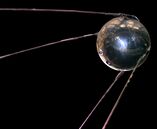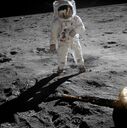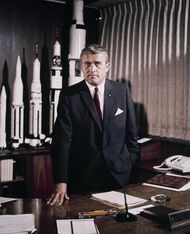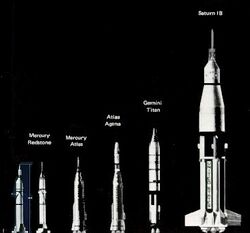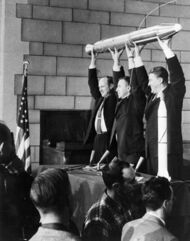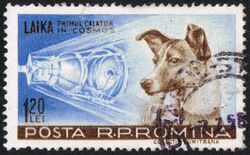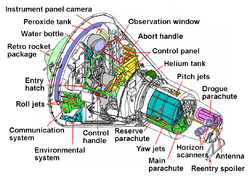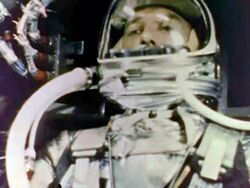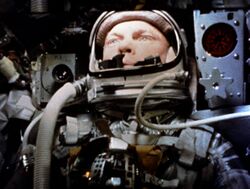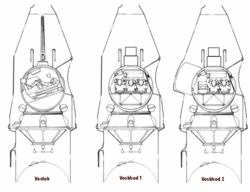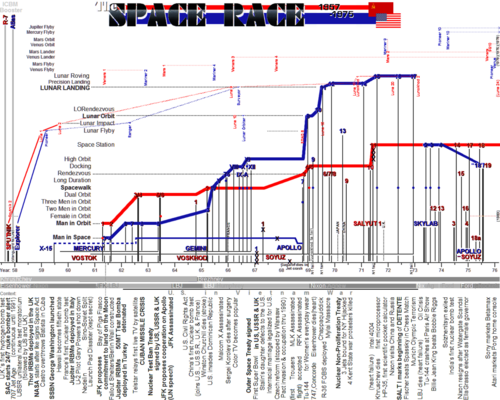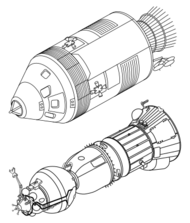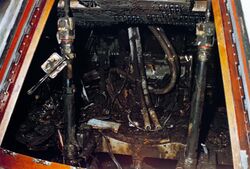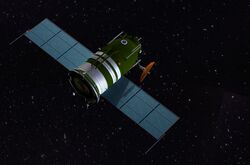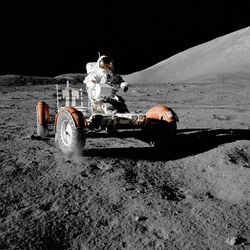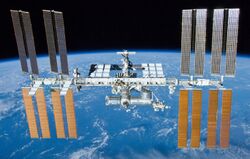Astronomy:Space Race
The Space Race was a 20th-century competition between two Cold War rivals, the United States and the Soviet Union, to achieve superior spaceflight capability. It had its origins in the ballistic missile-based nuclear arms race between the two nations following World War II and had its peak with the more particular Moon Race to land on the Moon between the US moonshot and Soviet moonshot programs. The technological advantage demonstrated by spaceflight achievement was seen as necessary for national security and became part of the symbolism and ideology of the time. The Space Race brought pioneering launches of artificial satellites, robotic space probes to the Moon, Venus, and Mars, and human spaceflight in low Earth orbit and ultimately to the Moon.[1]
Public interest in space travel originated in the 1951 publication of a Soviet youth magazine and was promptly picked up by US magazines.[2] The competition began on July 30, 1955, when the United States announced its intent to launch artificial satellites for the International Geophysical Year. Four days later, the Soviet Union responded by declaring they would also launch a satellite "in the near future". The launching of satellites was enabled by developments in ballistic missile capabilities since the end of World War II.[3] The competition gained Western public attention with the "Sputnik crisis", when the USSR achieved the first successful satellite launch, Sputnik 1, on October 4, 1957. It gained momentum when the USSR sent the first human, Yuri Gagarin, into space with the orbital flight of Vostok 1 on April 12, 1961. These were followed by a string of other early firsts achieved by the Soviets over the next few years.[4]
Gagarin's flight led US president John F. Kennedy to raise the stakes on May 25, 1961, by asking the US Congress to commit to the goal of "landing a man on the Moon and returning him safely to the Earth" before the end of the decade.[5] Both countries began developing super heavy-lift launch vehicles, with the US successfully deploying the Saturn V, which was large enough to send a three-person orbiter and two-person lander to the Moon. Kennedy's Moon landing goal was achieved in July 1969, with the flight of Apollo 11.[6][7][8] The conclusion of Apollo 11 is regarded by many Americans as ending the Space Race with an American victory.[9] This view is contested by some historians,[10] whilst space historian Asif A. Siddiqi proposed a more balanced view.[11] The USSR continued to pursue crewed lunar programs but did not succeed, with its N1 rocket to launch and land on the Moon before the US and eventually canceled it to concentrate on Salyut, the first space station program, and the first landings on Venus and on Mars. Meanwhile, the US landed five more Apollo crews on the Moon[12] and continued exploration of other extraterrestrial bodies robotically.
A period of détente followed with the April 1972 agreement on a cooperative Apollo–Soyuz Test Project (ASTP), resulting in the July 1975 rendezvous in Earth orbit of a US astronaut crew with a Soviet cosmonaut crew and joint development of an international docking standard APAS-75. Being considered as the final act of the Space Race,[9] the competition was only gradually replaced with cooperation.[13] The collapse of the Soviet Union eventually allowed the US and the newly founded Russian Federation to end their Cold War competition also in space, by agreeing in 1993 on the Shuttle–Mir and International Space Station programs.[14][15]
Origins
Although Germans, Americans and Soviets experimented with small liquid-fuel rockets before World War II, launching satellites and humans into space required the development of larger ballistic missiles such as Wernher von Braun's Aggregat-4 (A-4), which became known as the Vergeltungswaffe 2 (V-2) developed by Nazi Germany to bomb the Allies in the war.[16] After the war, both the US and USSR acquired custody of German rocket development assets which they used to leverage the development of their own missiles.
Public interest in space flight was first aroused in October 1951 when the Soviet rocketry engineer Mikhail Tikhonravov published "Flight to the Moon" in the newspaper Pionerskaya pravda for young readers. He described a two-person interplanetary spaceship of the future and the industrial and technological processes required to create it. He ended the short article with a clear forecast of the future: "We do not have long to wait. We can assume that the bold dream of Konstantin Tsiolkovsky will be realized within the next 10 to 15 years."[17] From March 1952 to April 1954, the US Collier's magazine reacted with a series of seven articles Man Will Conquer Space Soon! detailing Wernher von Braun's plans for crewed spaceflight. In March 1955, Disneyland's animated episode Man in Space in the US television with an audience of about 40 million people eventually fired the public enthusiasm for space travel and raised government interest, both in the US and USSR.
Missile race
Soon after the end of World War II, the two former allies became engaged in a state of political conflict and military tension known as the Cold War (1947–1991), which polarized Europe between the Soviet Union's satellite states (often referred to as the Eastern Bloc) and the states of the Western world allied with the U.S.[18]
Soviet rocket development
The first Soviet development of artillery rockets was in 1921 when the Soviet military sanctioned the Gas Dynamics Laboratory, a small research laboratory to explore solid fuel rockets, led by Nikolai Tikhomirov, who had begun studying solid and liquid-fueled rockets in 1894, and obtained a patent in 1915 for "self-propelled aerial and water-surface mines.[19][20] The first test-firing of a solid fuel rocket was carried out in 1928.[21]
Further development was carried out in the 1930s by the Group for the Study of Reactive Motion (GIRD), where Soviet rocket pioneers Sergey Korolev, Friedrich Zander, Mikhail Tikhonravov and Leonid Dushkin[22] launched GIRD-X, the first Soviet liquid-fueled rocket in 1933.[23] In 1933 the two design bureaus were combined into the Reactive Scientific Research Institute[24] and produced the RP-318, the USSR's first rocket-powered aircraft and the RS-82 and RS-132 missiles,[25] which became the basis for the Katyusha multiple rocket launcher,[26][27] During the 1930s Soviet rocket technology was comparable to Germany 's,[28] but Joseph Stalin 's Great Purge from 1936 to 1938 severely damaged its progress.
In 1945 the Soviets captured several key Nazi German A-4 (V-2) rocket production facilities, and also gained the services of some German scientists and engineers related to the project. A-4s were assembled and studied and the experience derived from assembling and launching A4 rockets was directly applied to the Soviet copy, called the R-1,[29][30] with NII-88 chief designer Sergei Korolev overseeing the R-1's development.,[31] The R-1 entered into service in the Soviet Army on 28 November 1950.[32][33] By the latter half of 1946, Korolev and rocket engineer Valentin Glushko had, with extensive input from German engineers, outlined a successor to the R-1, the R-2 with an extended frame and a new engine designed by Glushko, [34] which entered service in November, 1951, with a range of 600 kilometres (370 mi), twice that of the R-1.[35] This was followed in 1951 with the development of the R-5 Pobeda, the Soviet Union's first real strategic missile, with a range of 1,200 km (750 mi) and capable of carrying a 1 megaton (mt) thermonuclear warhead. The R-5 entered service in 1955.[36] Scientific versions of the R-1, R-2 and R-5 undertook various experiments between 1949 and 1958, including flights with space dogs.[37]:21–23
Design work began in 1953 on the R-7 Semyorka with the requirement for a missile with a launch mass of 170 to 200 tons, range of 8,500 km and carrying a 3,000 kg (6,600 lb) nuclear warhead, powerful enough to launch a nuclear warhead against the United States. In late 1953 the warhead’s mass was increased to 5.5 to 6 tons to accommodate the then planned theromonuclear bomb.[38][39] On the 21 August 1957 the R-7 flew 6,000 km (3,700 mi), and became the worlds’s first intercontinental ballistic missile.[40][39] Two months later the R-7 launched Sputnik 1, the first artificial satellite, into orbit, and became the basis for the R-7 family which includes Sputnik, Luna, Molniya, Vostok, and Voskhod space launchers, as well as later Soyuz variants. Several versions are still in use and it has become the world’s most reliable space launcher.[41][42]
American rocket development
Although American rocket pioneer Robert H. Goddard developed, patented, and flew small liquid-propellant rockets as early as 1914, he became a recluse when his ideas were ridiculed by an editorial in The New York Times . This left the United States as the only one of the major three World War II powers not to have its own rocket program, until Von Braun and his engineers were expatriated from Nazi Germany in 1945. The US acquired a large number of V-2 rockets and recruited von Braun and most of his engineering team in Operation Paperclip.[43] The team was sent to the Army's White Sands Proving Ground in New Mexico, in 1945.[44] They set about assembling the captured V-2s and began a program of launching them and instructing American engineers in their operation.[45] These tests led to the first photos of Earth from space, and the first two-stage rocket, the WAC Corporal-V-2 combination, in 1949.[45] The German rocket team was moved from Fort Bliss to the Army's new Redstone Arsenal, located in Huntsville, Alabama, in 1950.[46] From here, von Braun and his team developed the Army's first operational medium-range ballistic missile, the Redstone rocket, derivatives of which launched both America's first satellite, and the first piloted Mercury space missions.[46] It became the basis for both the Jupiter and Saturn family of rockets.[46]
Each of the United States armed services had its own ICBM development program. The Air Force began ICBM research in 1945 with the MX-774.[47] In 1950, von Braun began testing the Air Force PGM-11 Redstone rocket family at Cape Canaveral.[48] By 1957, a descendant of the Air Force MX-774 received top-priority funding.[47] and evolved into the Atlas-A, the first successful American ICBM.[47] Its upgraded version, the Atlas-D, later served as a nuclear ICBM and as the orbital launch vehicle for Project Mercury and the remote-controlled Agena Target Vehicle used in Project Gemini.[47]
First artificial satellites
In 1955, with both the United States and the Soviet Union building ballistic missiles that could be used to launch objects into space, the stage was set for nationalistic competition.[3] On July 29, 1955, James C. Hagerty, President Dwight D. Eisenhower's press secretary, announced that the United States intended to launch "small Earth circling satellites" between July 1, 1957, and December 31, 1958, as part of the US contribution to the International Geophysical Year (IGY).[3] On August 2, at the Sixth Congress of the International Astronautical Federation in Copenhagen, scientist Leonid I. Sedov told international reporters at the Soviet embassy of his country's intention to launch a satellite as well, in the "near future".[3]
Soviet planning
On August 30, 1955, Korolev managed to get the Soviet Academy of Sciences to create a commission whose purpose was to beat the Americans into Earth orbit: this was the de facto start date for the Space Race.[3] The Council of Ministers of the Soviet Union began a policy of treating development of its space program as top-secret. When the Sputnik project was first approved, one of the immediate courses of action the Politburo took was to consider what to announce to the world regarding their event. The Telegraph Agency of the Soviet Union (TASS) established precedents for all official announcements on the Soviet space program. The information eventually released did not offer details on who built and launched the satellite or why it was launched. However, the public release is illuminating in what it does reveal: "there is an abundance of arcane scientific and technical data... as if to overwhelm the reader with mathematics in the absence of even a picture of the object".[49]
The Soviet space program's use of secrecy served as both a tool to prevent the leaking of classified information between countries, and also to create a mysterious barrier between the space program and the Soviet populace. The program's nature embodied ambiguous messages concerning its goals, successes, and values. The program itself was so secret that a regular Soviet citizen could never achieve a concrete image of it, but rather a superficial picture of its history, present activities, or future endeavors. Launchings were not announced until they took place. Cosmonaut names were not released until they flew. Mission details were sparse. Outside observers did not know the size or shape of their rockets or cabins or most of their spaceships, except for the first Sputniks, lunar probes, and Venus probe.[50]
The Soviet military maintained control over the space program; Korolev's OKB-1 design bureau was subordinated under the Ministry of General Machine Building,[49] tasked with the development of intercontinental ballistic missiles, and continued to give its assets random identifiers into the 1960s.[49] They cloaked the program in a shroud of secrecy; public pronouncements were uniformly positive. As far as the public knew, the Soviet space program had never experienced failure. According to historian James Andrews, "With almost no exceptions, coverage of Soviet space exploits, especially in the case of human space missions, omitted reports of failure or trouble".[49]
Dominic Phelan says in the book Cold War Space Sleuths (Springer-Praxis 2013): "The USSR was famously described by Winston Churchill as 'a riddle, wrapped in a mystery, inside an enigma' and nothing signified this more than the search for the truth behind its space program during the Cold War. Although the Space Race was literally played out above our heads, it was often obscured by a figurative 'space curtain' that took much effort to see through".[50]
United States planning
Initially, President Eisenhower was worried that a satellite passing above a nation at over 100 kilometers (62 mi) might be seen as violating that nation's airspace.[51] He was concerned that the Soviet Union would accuse the Americans of an illegal overflight, thereby scoring a propaganda victory at his expense.[52] Eisenhower and his advisors were of the opinion that a nation's airspace sovereignty did not extend past the Kármán line, and they used the 1957–58 International Geophysical Year launches to establish this principle in international law.[51] Eisenhower also feared that he might cause an international incident and be called a "warmonger" if he were to use military missiles as launchers. Therefore, he selected the untried Naval Research Laboratory's Vanguard rocket, which was a research-only rocket.[53] This meant that von Braun's team was not allowed to put a satellite into orbit with their Jupiter-C rocket, because of its intended use as a future military vehicle.[53] On September 20, 1956, von Braun and his team did launch a Jupiter-C that was capable of putting a satellite into orbit, but the launch was used only as a suborbital test of reentry vehicle technology.[53]
Sputnik
Korolev received word about von Braun's 1956 Jupiter-C test and, mistakenly thinking it was a satellite mission that failed, expedited plans to get his own satellite in orbit. Since the R-7 was substantially more powerful than any of the US launch vehicles, he made sure to take full advantage of this capability by designing Object D as his primary satellite.[54] It was given the designation 'D', to distinguish it from other R-7 payload designations 'A', 'B', 'V', and 'G' which were nuclear weapon payloads.[55] Object D dwarfed the proposed US satellites, having a weight of 1,400 kilograms (3,100 lb), of which 300 kilograms (660 lb) would be composed of scientific instruments that would photograph the Earth, take readings on radiation levels, and check on the planet's magnetic field.[55] However, things were not going along well with the design and manufacturing of the satellite, so in February 1957, Korolev sought and received permission from the Council of Ministers to build a Prosteishy Sputnik (PS-1), or simple satellite.[54] The council also decreed that Object D be postponed until April 1958.[56] The new Sputnik was a metallic sphere that would be a much lighter craft, weighing 83.8 kilograms (185 lb) and having a 58-centimeter (23 in) diameter.[57] The satellite would not contain the complex instrumentation that Object D had, but had two radio transmitters operating on different short wave radio frequencies, the ability to detect if a meteoroid were to penetrate its pressure hull, and the ability to detect the density of the Earth's thermosphere.[58]
Korolev was buoyed by the first successful launches of the R-7 rocket in August and September, which paved the way for the launch of Sputnik.[59] Word came that the US was planning to announce a major breakthrough at an International Geophysical Year conference at the National Academy of Sciences in Washington D.C., with a paper titled "Satellite Over the Planet", on October 6, 1957.[60] Korolev anticipated that von Braun might launch a Jupiter-C with a satellite payload on or around October 4 or 5, in conjunction with the paper.[60] He hastened the launch, moving it to October 4.[60] The launch vehicle for PS-1 was a modified R-7 – vehicle 8K71PS number M1-PS – without much of the test equipment and radio gear that was present in the previous launches.[59] It arrived at the Soviet missile base Tyura-Tam in September and was prepared for its mission at launch site number one.[59] The first launch took place on Friday, October 4, 1957, at exactly 10:28:34 pm Moscow time, with the R-7 and the now named Sputnik 1 satellite lifting off the launch pad and placing the artificial "moon" into an orbit a few minutes later.[61] This "fellow traveler", as the name is translated in English, was a small, beeping ball, less than two feet in diameter and weighing less than 200 pounds. But the celebrations were muted at the launch control center until the down-range far east tracking station at Kamchatka received the first distinctive beep ... beep ... beep sounds from Sputnik 1's radio transmitters, indicating that it was on its way to completing its first orbit.[61] About 95 minutes after launch, the satellite flew over its launch site, and its radio signals were picked up by the engineers and military personnel at Tyura-Tam: that's when Korolev and his team celebrated the first successful artificial satellite placed into Earth-orbit.[62]
US response
CIA assessment
At the latest, the successful start of Sputnik 2 with its weight of more than 500 kg proved that the USSR had achieved a leading advantage in rocket technology. The dumbfounded CIA estimated the launch weight at 500 metric tons requiring an initial thrust of more than 1,000 tons and supposed the use of a three-stage rocket. In a secret report, it concluded that ″the launching of two earth satellites must have been a stupendous scientific achievement. ... Launching of these satellites does indicate, however, that the USSR has perfected an ICBM which they can put on any desired target with accuracy."[63] In reality, the launch weight of the Soviet rocket was 267 metric tons with an initial thrust of 410 tons with one and a half stages. The CIA's misjudgement was caused by extrapolating the parameters of the US Atlas rocket developed at the same time (launch weight 82 tons, initial thrust 135 tones, maximum payload of 70 kg for low Earth orbit).[64] In part, the favourable data of the Soviet launcher was based on concepts proposed by the German rocket scientists headed by Helmut Gröttrup on Gorodomlya Island, such as, among other things, the rigorous weight saving, the control of the residual fuel quantities and a reduced thrust to weight relation of 1.4 instead of usual factor 2.[65] The CIA had heard about such details already in January 1954 when it interrogated Göttrup after his return from the USSR but did not take him seriously.[66]
US reactions
The Soviet success raised a great deal of concern in the United States. For example, economist Bernard Baruch wrote in an open letter titled "The Lessons of Defeat" to the New York Herald Tribune: "While we devote our industrial and technological power to producing new model automobiles and more gadgets, the Soviet Union is conquering space. ... It is Russia, not the United States, who has had the imagination to hitch its wagon to the stars and the skill to reach for the moon and all but grasp it. America is worried. It should be."[67]
Eisenhower ordered project Vanguard to move up its timetable and launch its satellite much sooner than originally planned.[68] The December 6, 1957 Project Vanguard launch failure occurred at Cape Canaveral Air Force Station in Florida. It was a monumental failure, exploding a few seconds after launch, and it became an international joke. The satellite appeared in newspapers under the names Flopnik, Stayputnik, Kaputnik,[69] and Dudnik.[70] In the United Nations, the Soviet delegate offered the US representative aid "under the Soviet program of technical assistance to backwards nations."[69] Only in the wake of this very public failure did von Braun's Redstone team get the go-ahead to launch their Jupiter-C rocket as soon as they could. In Britain, the US's Western Cold War ally, the reaction was mixed: some celebrated the fact that the Soviets had reached space first, while others feared the destructive potential that military uses of spacecraft might bring.[71] The Daily Express predicted that the US would catch up to and pass the USSR in space; "never doubt for a moment that America would be successful".[72]
On January 31, 1958, nearly four months after the launch of Sputnik 1, von Braun and the United States successfully launched its first satellite on a four-stage Juno I rocket derived from the US Army's Redstone missile, at Cape Canaveral.[73] The satellite Explorer 1 was 30.66 pounds (13.91 kg) in mass.[73] The payload of Explorer 1 weighed 18.35 pounds (8.32 kg). It carried a micrometeorite gauge and a Geiger-Müller tube. It passed in and out of the Earth-encompassing radiation belt with its 194-by-1,368-nautical-mile (360 by 2,534 km) orbit, therefore saturating the tube's capacity and proving what Dr. James Van Allen, a space scientist at the University of Iowa, had theorized.[73] The belt, named the Van Allen radiation belt, is a doughnut-shaped zone of high-level radiation intensity around the Earth above the magnetic equator.[74] Van Allen was also the man who designed and built the satellite instrumentation of Explorer 1. The satellite measured three phenomena: cosmic ray and radiation levels, the temperature in the spacecraft, and the frequency of collisions with micrometeorites. The satellite had no memory for data storage, therefore it had to transmit continuously.[75] In March 1958 a second satellite was sent into orbit with augmented cosmic ray instruments.
Creation of NASA
On April 2, 1958, President Eisenhower reacted to the Soviet space lead in launching the first satellite by recommending to the US Congress that a civilian agency be established to direct nonmilitary space activities. Congress, led by Senate Majority Leader Lyndon B. Johnson, responded by passing the National Aeronautics and Space Act, which Eisenhower signed into law on July 29, 1958. This law turned the National Advisory Committee on Aeronautics into the National Aeronautics and Space Administration (NASA). It also created a Civilian-Military Liaison Committee, appointed by the President, responsible for coordinating the nation's civilian and military space programs.[76]
On October 21, 1959, Eisenhower approved the transfer of the Army's remaining space-related activities to NASA. On July 1, 1960, the Redstone Arsenal became NASA's George C. Marshall Space Flight Center, with von Braun as its first director. Development of the Saturn rocket family, which when mature gave the US parity with the Soviets in terms of lifting capability, was thus transferred to NASA.[77]
Robotic lunar probes
In 1958, Korolev upgraded the R-7 to be able to launch a 400-kilogram (880 lb) payload to the Moon. The Luna program began with three failed secret 1958 attempts to launch Luna E-1-class impactor probes.[78] The fourth attempt, Luna 1, launched successfully on January 2, 1959, but missed the Moon. The fifth attempt on June 18 also failed at launch. The 390-kilogram (860 lb) Luna 2 successfully impacted the Moon on September 14, 1959. The 278.5-kilogram (614 lb) Luna 3 successfully flew by the Moon and sent back pictures of its far side on October 7, 1959.[79]
The US first embarked on the Pioneer program in 1958 by launching the first probe, albeit ending in failure. A subsequent probe named Pioneer 1 was launched with the intention of orbiting the Moon only to result in a partial mission success when it reached an apogee of 113,800 km before falling back to Earth. The missions of Pioneer 2 and Pioneer 3 failed whereas Pioneer 4 had one partially successful lunar flyby in March 1959.[80][81]
The Ranger program was started in 1959 by NASA's Jet Propulsion Laboratory. The Block I Ranger 1 and Ranger 2 suffered Atlas-Agena launch failures in August and November 1961. The 727-pound (330 kg) Block II Ranger 3 launched successfully on January 26, 1962, but missed the Moon. The 730-pound (330 kg) Ranger 4 became the first US spacecraft to reach the Moon, but its solar panels and navigational system failed near the Moon and it impacted the far side without returning any scientific data. Ranger 5 ran out of power and missed the Moon by 725 kilometers (391 nmi) on October 21, 1962. The first successful Ranger mission was the 806-pound (366 kg) Block III Ranger 7 which impacted on July 31, 1964.[82] Ranger had three successful impactors out of nine attempts.[83]
The Surveyor program had five successful soft landings out of seven attempts from 1966 to 1968. The Lunar Orbiter program had five successes out of five attempts in 1966–1967.
First mammals in space
The US and the USSR sent animals into space to determine the safety of the environment before sending the first humans. The USSR used dogs for this purpose, and the US used monkeys and apes. The first mammal in space was Albert II, a rhesus monkey launched by the US on a sub-orbital flight on June 14, 1949, who died on landing due to a parachute malfunction.[84]
The USSR sent the dog Laika into orbit on Sputnik 2 on November 3, 1957, for an intended ten-day flight. They did not yet have the technology to return Laika safely to Earth, and the government reported Laika died when the oxygen ran out,[85] but in October 2002 her true cause of death was reported as stress and overheating on the fourth orbit[86] due to failure of the air conditioning system.[87] At a Moscow press conference in 1998 Oleg Gazenko, a senior Soviet scientist involved in the project, stated "The more time passes, the more I'm sorry about it. We did not learn enough from the mission to justify the death of the dog...".[88]
On August 19, 1960, the dogs Belka and Strelka were sent into orbit aboard Sputnik 5 and safely returned.
The Americans sent the chimpanzee Ham on a suborbital flight of the Mercury capsule on Mercury-Redstone 2 and recovered him safely on January 31, 1961.[89][90]
The chimpanzee Enos was launched on Mercury-Atlas 5 on November 29, 1961, into what was supposed to be a three-orbit flight.[91] However, the mission was aborted after two orbits due to capsule overheating, and a malfunctioning "avoidance conditioning" test subjecting him to 76 electrical shocks.[92]
First humans in space
Vostok
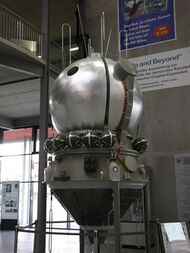
The Soviets designed their first human space capsule using the same spacecraft bus as their Zenit spy satellite,[93] forcing them to keep the details and true appearance secret until after the Vostok program was over. The craft consisted of a spherical descent module with a mass of 2.46 tonnes (5,400 lb) and a diameter of 2.3 meters (7.5 ft), with a cylindrical inner cabin housing the cosmonaut, instruments, and escape system; and a biconic instrument module with a mass of 2.27 tonnes (5,000 lb), 2.25 meters (7.4 ft) long and 2.43 meters (8.0 ft) in diameter, containing the engine system and propellant. After reentry, the cosmonaut would eject at about 7,000 meters (23,000 ft) over the USSR and descend via parachute, while the capsule would land separately, because the descent module made an extremely rough landing that could have left a cosmonaut seriously injured.[94] The "Vostok spaceship" was first displayed at the July 1961 Tushino air show, mounted on its launch vehicle's third stage, with the nose cone in place concealing the spherical capsule. A tail section with eight fins was added in an apparent attempt to confuse western observers. This also appeared on official commemorative stamps and a documentary.[95] The Soviets finally revealed the true appearance of their Vostok capsule at the April 1965 Moscow Economic Exhibition.
On April 12, 1961, the USSR surprised the world by launching Yuri Gagarin into a single, 108-minute orbit around the Earth in a craft called Vostok 1.[94] They dubbed Gagarin the first cosmonaut, roughly translated from Russian and Greek as "sailor of the universe". Gagarin's capsule was flown in automatic mode, since doctors did not know what would happen to a human in the weightlessness of space; but Gagarin was given an envelope containing the code that would unlock manual control in an emergency.[94]
Gagarin became a national hero of the Soviet Union and the Eastern Bloc, and a worldwide celebrity. Moscow and other cities in the USSR held mass demonstrations, the scale of which was second only to the World War II Victory Parade of 1945.[96] April 12 was declared Cosmonautics Day in the USSR, and is celebrated today in Russia as one of the official "Commemorative Dates of Russia."[97] In 2011, it was declared the International Day of Human Space Flight by the United Nations .[98]
The USSR demonstrated 24-hour launch pad turnaround and launched two piloted spacecraft, Vostok 3 and Vostok 4, in essentially identical orbits, on August 11 and 12, 1962.[99] The two spacecraft came within approximately 6.5 kilometers (3.5 nautical miles) of one another, close enough for radio communication,[100] but then drifted as far apart as 2,850 kilometers (1,540 nautical miles). The Vostok had no maneuvering rockets to keep the two craft a controlled distance apart.[101] Vostok 4 also set a record of nearly four days in space. The first woman, Valentina Tereshkova, was launched into space on Vostok 6 on June 16, 1963,[102] as (possibly) a medical experiment. She was the only one to fly of a small group of female parachutist factory workers (unlike the male cosmonauts who were military test pilots),[103] chosen by the head of cosmonaut training because he read a tabloid article about the "Mercury 13" group of women wanting to become astronauts, and got the mistaken idea that NASA was actually entertaining this.[104][102] Five months after her flight, Tereshkova married Vostok 3 cosmonaut Andriyan Nikolayev,[105] and they had a daughter.[106]
Mercury
The US Air Force had been developing a program to launch the first man in space, named Man in Space Soonest. This program studied several different types of one-man space vehicles, settling on a ballistic re-entry capsule launched on a derivative Atlas missile, and selecting a group of nine candidate pilots. After NASA's creation, the program was transferred over to the civilian agency's Space Task Group and renamed Project Mercury on November 26, 1958. The Mercury spacecraft was designed by the STG's chief engineer Maxime Faget. NASA selected a new group of astronaut (from the Greek for "star sailor") candidates from Navy, United States Air Force and Marine test pilots, and narrowed this down to a group of seven for the program. Capsule design and astronaut training began immediately, working toward preliminary suborbital flights on the Redstone missile, followed by orbital flights on the Atlas. Each flight series would first start unpiloted, then carry a non-human primate, then finally humans.
The Mercury spacecraft's principal designer was Maxime Faget, who started research for human spaceflight during the time of the NACA.[107] It consisted of a conical capsule with a cylindrical pack of three solid-fuel retro-rockets strapped over a beryllium or fiberglass heat shield on the blunt end. Base diameter at the blunt end was 6.0 feet (1.8 m) and length was 10.8 feet (3.3 m); with the launch escape system added, the overall length was 25.9 feet (7.9 m).[108] With 100 cubic feet (2.8 m3) of habitable volume, the capsule was just large enough for a single astronaut.[109] The first suborbital spacecraft weighed 3,000 pounds (1,400 kg); the heaviest, Mercury-Atlas 9, weighed 3,000 pounds (1,400 kg) fully loaded.[110] On reentry, the astronaut would stay in the craft through splashdown by parachute in the Atlantic Ocean.
On May 5, 1961, Alan Shepard became the first American in space, launching in a ballistic trajectory on Mercury-Redstone 3, in a spacecraft he named Freedom 7.[111] Though he did not achieve orbit like Gagarin, he was the first person to exercise manual control over his spacecraft's attitude and retro-rocket firing.[112] After his successful return, Shepard was celebrated as a national hero, honored with parades in Washington, New York and Los Angeles, and received the NASA Distinguished Service Medal from President John F. Kennedy.[113]
American Virgil "Gus" Grissom repeated Shepard's suborbital flight in Liberty Bell 7 on July 21, 1961.[114] Almost a year after the Soviet Union put a human into orbit, astronaut John Glenn became the first American to orbit the Earth, on February 20, 1962.[115] His Mercury-Atlas 6 mission completed three orbits in the Friendship 7 spacecraft, and splashed down safely in the Atlantic Ocean, after a tense reentry, due to what falsely appeared from the telemetry data to be a loose heat-shield.[115] On February 23, 1962, President Kennedy awarded Glenn with the NASA Distinguished Service Medal in a ceremony at Cape Canaveral Air Force Station .[116] As the first American in orbit, Glenn became a national hero, and received a ticker-tape parade in New York City , reminiscent of that given for Charles Lindbergh.
The United States launched three more Mercury flights after Glenn's: Aurora 7 on May 24, 1962, duplicated Glenn's three orbits, Sigma 7 on October 3, 1962, six orbits, and Faith 7 on May 15, 1963, 22 orbits (32.4 hours), the maximum capability of the spacecraft. NASA at first intended to launch one more mission, extending the spacecraft's endurance to three days, but since this would not beat the Soviet record, it was decided instead to concentrate on developing Project Gemini.[117]
Kennedy aims for the Moon
... if we are to win the battle that is now going on around the world between freedom and tyranny, the dramatic achievements in space which occurred in recent weeks should have made clear to us all, as did the Sputnik in 1957, the impact of this adventure on the minds of men everywhere, who are attempting to make a determination of which road they should take. ... Now it is time to take longer strides – time for a great new American enterprise – time for this nation to take a clearly leading role in space achievement, which in many ways may hold the key to our future on Earth.
... Recognizing the head start obtained by the Soviets with their large rocket engines, which gives them many months of lead-time, and recognizing the likelihood that they will exploit this lead for some time to come in still more impressive successes, we nevertheless are required to make new efforts on our own.
... I believe that this nation should commit itself to achieving the goal, before this decade is out, of landing a man on the Moon and returning him safely to the Earth. No single space project in this period will be more impressive to mankind, or more important for the long-range exploration of space, and none will be so difficult or expensive to accomplish.
... Let it be clear that I am asking the Congress and the country to accept a firm commitment to a new course of action—a course which will last for many years and carry very heavy costs: 531 million dollars in fiscal '62—an estimated seven to nine billion dollars additional over the next five years. If we are to go only half way, or reduce our sights in the face of difficulty, in my judgment it would be better not to go at all.John F. Kennedy,
Special Message to Congress on Urgent National Needs, May 25, 1961[5]
Before Gagarin's flight, US President John F. Kennedy's support for America's piloted space program was lukewarm. Jerome Wiesner of MIT, who served as a science advisor to presidents Eisenhower and Kennedy, and himself an opponent of sending humans into space, remarked, "If Kennedy could have opted out of a big space program without hurting the country in his judgment, he would have."[118] As late as March 1961, when NASA administrator James E. Webb submitted a budget request to fund a Moon landing before 1970, Kennedy rejected it because it was simply too expensive.[119] Some were surprised by Kennedy's eventual support of NASA and the space program because of how often he had attacked the Eisenhower administration's inefficiency during the election.[120]
Gagarin's flight changed this; now Kennedy sensed the humiliation and fear on the part of the American public over the Soviet lead. Additionally, the Bay of Pigs invasion, planned before his term began but executed during it, was an embarrassment to his administration due to the colossal failure of the US forces.[121] Looking for something to save political face, he sent a memo dated April 20, 1961, to Vice President Lyndon B. Johnson, asking him to look into the state of America's space program, and into programs that could offer NASA the opportunity to catch up.[122] The two major options at the time were either the establishment of an Earth orbital space station or a crewed landing on the Moon. Johnson, in turn, consulted with von Braun, who answered Kennedy's questions based on his estimates of US and Soviet rocket lifting capability.[123] Based on this, Johnson responded to Kennedy, concluding that much more was needed to reach a position of leadership, and recommending that the crewed Moon landing was far enough in the future that the US had a fighting chance to achieve it first.[124]
Kennedy ultimately decided to pursue what became the Apollo program, and on May 25 took the opportunity to ask for Congressional support in a Cold War speech titled "Special Message on Urgent National Needs". Full text ![]() He justified the program in terms of its importance to national security, and its focus of the nation's energies on other scientific and social fields.[125] He rallied popular support for the program in his "We choose to go to the Moon" speech, on September 12, 1962, before a large crowd at Rice University Stadium, in Houston, Texas, near the construction site of the new Lyndon B. Johnson Space Center facility.[125] Full text
He justified the program in terms of its importance to national security, and its focus of the nation's energies on other scientific and social fields.[125] He rallied popular support for the program in his "We choose to go to the Moon" speech, on September 12, 1962, before a large crowd at Rice University Stadium, in Houston, Texas, near the construction site of the new Lyndon B. Johnson Space Center facility.[125] Full text ![]()
Khrushchev responded to Kennedy's challenge with silence, refusing to publicly confirm or deny the Soviets were pursuing a "Moon race". As later disclosed, the Soviet Union secretly pursued two competing crewed lunar programs. Soviet Decree 655–268, On Work on the Exploration of the Moon and Mastery of Space, issued in August 1964, directed Vladimir Chelomei to develop a Moon flyby program with a projected first flight by the end of 1966, and directed Korolev to develop the Moon landing program with a first flight by the end of 1967.[126] In September 1965, Chelomei's flyby program was assigned to Korolev, who redesigned the cislunar mission to use his own Soyuz 7K-L1 spacecraft and Chelomei's Proton rocket. After Korolev's death in January 1966, another government decree of February 1967 moved the first crewed flyby to mid-1967, and the first crewed landing to the end of 1968.
Proposed joint US-USSR program
After a first US-USSR Dryden-Blagonravov agreement and cooperation on the Echo II balloon satellite in 1962,[13] President Kennedy proposed on September 20, 1963, in a speech before the United Nations General Assembly, that the United States and the Soviet Union join forces in an effort to reach the Moon.[127] Kennedy thus changed his mind regarding the desirability of the space race, preferring instead to ease tensions with the Soviet Union by cooperating on projects such as a joint lunar landing.[128] Soviet Premier Nikita Khrushchev initially rejected Kennedy's proposal.[129] However, on October 2, 1997, it was reported that Khrushchev's son Sergei claimed Khrushchev was poised to accept Kennedy's proposal at the time of Kennedy's assassination on November 22, 1963. During the next few weeks he reportedly concluded that both nations might realize cost benefits and technological gains from a joint venture, and decided to accept Kennedy's offer based on a measure of rapport during their years as leaders of the world's two superpowers, but changed his mind and dropped the idea since he did not have the same trust for Kennedy's successor, Lyndon Johnson.[129]
Some cooperation in robotic space exploration nevertheless did take place,[130] such as a combined Venera 4–Mariner 5 data analysis under a joint Soviet–American working group of COSPAR in 1969, allowing a more complete drawing of the profile of the atmosphere of Venus.[131][132] Eventually the Apollo-Soyuz mission was realized afterall, which furthermore laid the foundations for the Shuttle-Mir program and the ISS.
As President, Johnson steadfastly pursued the Gemini and Apollo programs, promoting them as Kennedy's legacy to the American public. One week after Kennedy's death, he issued Executive Order 11129 renaming the Cape Canaveral and Apollo launch facilities after Kennedy.
First crewed spacecraft
Focused by the commitment to a Moon landing, in January 1962 the US announced Project Gemini, a two-person spacecraft that would support the later three-person Apollo by developing the key spaceflight technologies of space rendezvous and docking of two craft, flight durations of sufficient length to go to the Moon and back, and extra-vehicular activity to perform work outside the spacecraft.[133][134]
Meanwhile, Korolev had planned further long-term missions for the Vostok spacecraft, and had four Vostoks in various stages of fabrication in late 1963 at his OKB-1 facilities.[135] The Americans' announced plans for Gemini represented major advances over the Mercury and Vostok capsules, and Korolev felt the need to try to beat the Americans to many of these innovations.[135] He had already begun designing the Vostok's replacement, the next-generation Soyuz, a multi-cosmonaut spacecraft that had at least the same capabilities as the Gemini spacecraft.[136] Soyuz would not be available for at least three years, and it could not be called upon to deal with this new American challenge in 1964 or 1965.[137] Political pressure in early 1964 – which some sources claim was from Khrushchev while other sources claim was from other Communist Party officials – pushed him to modify his four remaining Vostoks to beat the Americans to new space firsts in the size of flight crews, and the duration of missions.[135]
Voskhod
Korolev's conversion of his surplus Vostok capsules to the Voskhod spacecraft allowed the Soviet space program to beat the Gemini program in achieving the first spaceflight with a multi-person crew, and the first "spacewalk". Gemini took a year longer than planned to make its first flight, so Voskhod 1 became the first spaceflight with a three-person crew on October 12, 1964.[138] The USSR touted another "technological achievement" during this mission: it was the first space flight during which cosmonauts performed in a shirt-sleeve-environment.[139] However, flying without spacesuits was not due to safety improvements in the Soviet spacecraft's environmental systems; rather this was because the craft's limited cabin space did not allow for spacesuits. Flying without spacesuits exposed the cosmonauts to significant risk in the event of potentially fatal cabin depressurization.[139] This was not repeated until the US Apollo Command Module flew in 1968; the command module cabin was designed to transport three astronauts in a low pressure, pure oxygen shirt-sleeve environment while in space.
On March 18, 1965, about a week before the first piloted Project Gemini space flight, the USSR launched the two-cosmonaut Voskhod 2 mission with Pavel Belyayev and Alexei Leonov.[140] Voskhod 2's design modifications included the addition of an inflatable airlock to allow for extravehicular activity (EVA), also known as a spacewalk, while keeping the cabin pressurized so that the capsule's electronics would not overheat.[141] Leonov performed the first-ever EVA as part of the mission.[140] A fatality was narrowly avoided when Leonov's spacesuit expanded in the vacuum of space, preventing him from re-entering the airlock.[142] In order to overcome this, he had to partially depressurize his spacesuit to a potentially dangerous level.[142] He succeeded in safely re-entering the spacecraft, but he and Belyayev faced further challenges when the spacecraft's atmospheric controls flooded the cabin with 45% pure oxygen, which had to be lowered to acceptable levels before re-entry.[143] The reentry involved two more challenges: an improperly timed retrorocket firing caused the Voskhod 2 to land 386 kilometers (240 mi) off its designated target area, the city of Perm; and the instrument compartment's failure to detach from the descent apparatus caused the spacecraft to become unstable during reentry.[143]
By October 16, 1964, Leonid Brezhnev and a small cadre of high-ranking Communist Party officials deposed Khrushchev as Soviet government leader a day after Voskhod 1 landed, in what was called the "Wednesday conspiracy".[144] The new political leaders, along with Korolev, ended the technologically troublesome Voskhod program, cancelling Voskhod 3 and 4, which were in the planning stages, and started concentrating on reaching the Moon.[145] Voskhod 2 ended up being Korolev's final achievement before his death on January 14, 1966, as it became the last of the space firsts that the USSR achieved during the early 1960s. According to historian Asif Siddiqi, Korolev's accomplishments marked "the absolute zenith of the Soviet space program, one never, ever attained since."[4] There was a two-year pause in Soviet piloted space flights while Voskhod's replacement, the Soyuz spacecraft, was designed and developed. [146]
Gemini
Though delayed a year to reach its first flight, Gemini was able to take advantage of the USSR's two-year hiatus after Voskhod, which enabled the US to catch up and surpass the previous Soviet superiority in piloted spaceflight. Gemini had ten crewed missions between March 1965 and November 1966: Gemini 3, Gemini 4, Gemini 5, Gemini 6A, Gemini 7, Gemini 8, Gemini 9A, Gemini 10, Gemini 11, and Gemini 12; and accomplished the following:
- Every mission demonstrated the ability to change the craft's orbit.
- Gemini 5 demonstrated eight-day endurance, long enough for a round trip to the Moon. Gemini 7 demonstrated a fourteen-day endurance flight.
- Gemini 6A demonstrated rendezvous and station-keeping with Gemini 7 for three consecutive orbits at distances as close as 1 foot (0.30 m).[147] Gemini 9A also achieved rendezvous with an Agena Target Vehicle (ATV).
- Rendezvous and docking with the ATV was achieved on Gemini 8, 10, 11, and 12. Gemini 11 achieved the first direct-ascent rendezvous with its Agena target on the first orbit.
- Extravehicular activity (EVA) was perfected through increasing practice on Gemini 4, 9A, 10, 11, and 12. On Gemini 12, Edwin "Buzz" Aldrin spent over five hours working comfortably during three (EVA) sessions, finally proving that humans could perform productive tasks outside their spacecraft.
- Gemini 10, 11, and 12 used the ATV's engine to make large changes in its orbit while docked. Gemini 11 used the Agena's rocket to achieve a crewed Earth orbit record apogee of 742 nautical miles (1,374 km).
Gemini 8 experienced the first in-space mission abort on March 17, 1966, just after achieving the world's first docking, when a stuck or shorted thruster sent the craft into an uncontrolled spin. Command pilot Neil Armstrong was able to shut off the stuck thruster and stop the spin by using the re-entry control system.[148] He and his crewmate David Scott landed and were recovered safely.[149]
Most of the novice pilots on the early missions would command the later missions. In this way, Project Gemini built up spaceflight experience for the pool of astronauts for the Apollo lunar missions. With the completion of Gemini, the US had demonstrated all the technologies necessary to make Kennedy's goal of landing a man on the Moon, with the exception of developing a large enough launch vehicle.
Soviet crewed Moon programs
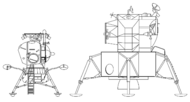
Korolev's design bureau produced two prospectuses for circumlunar spaceflight (March 1962 and May 1963), the main spacecraft for which were early versions of his Soyuz design. Soviet Communist Party Central Committee Command 655-268 officially established two secret, competing crewed programs for circumlunar flights and lunar landings, on August 3, 1964. The circumlunar flights were planned to occur in 1967, and the landings to start in 1968.[150]
The circumlunar program (Zond), created by Vladimir Chelomey's design bureau OKB-52, was to fly two cosmonauts in a stripped-down Soyuz 7K-L1, launched by Chelomey's Proton UR-500 rocket. The Zond sacrificed habitable cabin volume for equipment, by omitting the Soyuz orbital module. Chelomey gained favor with Khrushchev by employing members of his family.
Korolev's lunar landing program was designated N1/L3, for its N1 super rocket and a more advanced Soyuz 7K-L3 spacecraft, also known as the lunar orbital module ("Lunniy Orbitalny Korabl", LOK), with a crew of two. A separate lunar lander ("Lunniy Korabl", LK), would carry a single cosmonaut to the lunar surface.[150]
The N1/L3 launch vehicle had three stages to Earth orbit, a fourth stage for Earth departure, and a fifth stage for lunar landing assist. The combined space vehicle was roughly the same height and takeoff mass as the three-stage US Apollo-Saturn V and exceeded its takeoff thrust by 28% (45,400 kN vs. 33,000 kN), but had only about half the translunar injection payload capability.[151] The Saturn V used liquid hydrogen fuel in its two upper stages, and carried a 48.6-tonne (107,000 lb) payload to the Moon,[152] enough for a three-person orbiter and two-person lander. The USSR did not use liquid hydrogen until after the N-1 was canceled, therefore it was only capable of a 23.5-tonne (52,000 lb) translunar payload.
Following Khrushchev's ouster from power, Chelomey's Zond program was merged into the N1/L3 program.[153]
Outer space treaty
The US and USSR began discussions on the peaceful uses of space as early as 1958, presenting issues for debate to the United Nations ,[154][155][156] which created a Committee on the Peaceful Uses of Outer Space in 1959.[157]
On May 10, 1962, Vice President Johnson addressed the Second National Conference on the Peaceful Uses of Space revealing that the United States and the USSR both supported a resolution passed by the Political Committee of the UN General Assembly in December 1962, which not only urged member nations to "extend the rules of international law to outer space," but to also cooperate in its exploration. Following the passing of this resolution, Kennedy commenced his communications proposing a cooperative American and Soviet space program.[158]
The UN ultimately created a Treaty on Principles Governing the Activities of States in the Exploration and Use of Outer Space, including the Moon and Other Celestial Bodies, which was signed by the United States, the USSR, and the United Kingdom on January 27, 1967, and came into force the following October 10.[159]
This treaty:
- bars party States from placing weapons of mass destruction in Earth orbit, on the Moon, or any other celestial body;
- exclusively limits the use of the Moon and other celestial bodies to peaceful purposes, and expressly prohibits their use for testing weapons of any kind, conducting military maneuvers, or establishing military bases, installations, and fortifications;
- declares that the exploration of outer space shall be done to benefit all countries and shall be free for exploration and use by all the States;
- explicitly forbids any government from claiming a celestial resource such as the Moon or a planet, claiming that they are the common heritage of mankind, "not subject to national appropriation by claim of sovereignty, by means of use or occupation, or by any other means". However, the State that launches a space object retains jurisdiction and control over that object;
- holds any State liable for damages caused by their space object;
- declares that "the activities of non-governmental entities in outer space, including the Moon and other celestial bodies, shall require authorization and continuing supervision by the appropriate State Party to the Treaty", and "States Parties shall bear international responsibility for national space activities whether carried out by governmental or non-governmental entities"; and
- "A State Party to the Treaty which has reason to believe that an activity or experiment planned by another State Party in outer space, including the Moon and other celestial bodies, would cause potentially harmful interference with activities in the peaceful exploration and use of outer space, including the Moon and other celestial bodies, may request consultation concerning the activity or experiment."
The treaty remains in force, signed by 107 member states. – (As of July 2017)
Disaster strikes both sides
In 1967, both nations' space programs faced serious challenges that brought them to temporary halts.
Apollo 1
On January 27, 1967, the same day the US and USSR signed the Outer Space Treaty, the crew of the first crewed Apollo mission, Command Pilot Virgil "Gus" Grissom, Senior Pilot Ed White, and Pilot Roger Chaffee, were killed in a fire that swept through their spacecraft cabin during a ground test, less than a month before the planned February 21 launch. An investigative board determined the fire was probably caused by an electrical spark and quickly grew out of control, fed by the spacecraft's atmosphere of pure oxygen at greater than one standard atmosphere. Crew escape was made impossible by inability to open the plug door hatch cover against the internal pressure.[160] The board also found design and construction flaws in the spacecraft, and procedural failings, including failure to appreciate the hazard of the pure-oxygen atmosphere, as well as inadequate safety procedures.[160] All these flaws had to be corrected over the next twenty-two months until the first piloted flight could be made.[160] Mercury and Gemini veteran Grissom had been a favored choice of Deke Slayton, NASA's Director of Flight Crew Operations, to make the first piloted landing.[161]
Soyuz 1
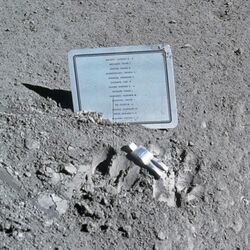
On April 24, 1967, the single pilot of Soyuz 1, Vladimir Komarov, became the first in-flight spaceflight fatality. The mission was planned to be a three-day test, to include the first Soviet docking with an unpiloted Soyuz 2, but the mission was plagued with problems. Early on, Komarov's craft lacked sufficient electrical power because only one of two solar panels had deployed. Then the automatic attitude control system began malfunctioning and eventually failed completely, resulting in the craft spinning wildly. Komarov was able to stop the spin with the manual system, which was only partially effective. The flight controllers aborted his mission after only one day. During the emergency re-entry, a fault in the landing parachute system caused the primary chute to fail, and the reserve chute became tangled with the drogue chute, causing descent speed to reach as high as 40 m/s (140 km/h; 89 mph). Shortly thereafter, Soyuz 1 impacted the ground 3 km (1.9 mi) west of Karabutak, exploding into a ball of flames. The official autopsy states Komarov died of blunt force trauma on impact, and that the subsequent heat mutilation of his corpse was a result of the explosive impact. Fixing the spacecraft's faults caused an eighteen-month delay before piloted Soyuz flights could resume.
Both programs recover
The United States recovered from the Apollo 1 fire, fixing the fatal flaws in an improved version of the Block II command module. The US proceeded with unpiloted test launches of the Saturn V launch vehicle (Apollo 4 and Apollo 6) and the Lunar Module (Apollo 5) during the latter half of 1967 and early 1968.[162] The first Saturn V flight was an unqualified success, and although the second suffered some non-catastrophic engine failures, it was considered a partial success and the launcher achieved human rating qualification. Apollo 1's mission to check out the Apollo Command and Service Module in Earth orbit was accomplished by Grissom's backup crew on Apollo 7, launched on October 11, 1968.[163] The eleven-day mission was a total success, as the spacecraft performed a virtually flawless mission, paving the way for the United States to continue with its lunar mission schedule.[164]
The Soviet Union also fixed the parachute and control problems with Soyuz, and the next piloted mission Soyuz 3 was launched on October 26, 1968.[165] The goal was to complete Komarov's rendezvous and docking mission with the un-piloted Soyuz 2.[165] Ground controllers brought the two craft to within 200 meters (660 ft) of each other, then cosmonaut Georgy Beregovoy took control.[165] He got within 40 meters (130 ft) of his target, but was unable to dock before expending 90 percent of his maneuvering fuel, due to a piloting error that put his spacecraft into the wrong orientation and forced Soyuz 2 to automatically turn away from his approaching craft.[165] The first docking of Soviet spacecraft was finally realized in January 1969 by the Soyuz 4 and Soyuz 5 missions. It was the first-ever docking of two crewed spacecraft, and the first transfer of crew from one space vehicle to another.[166]
The Soviet Zond spacecraft was not yet ready for piloted circumlunar missions in 1968, after six unsuccessful automated test launches: Kosmos 146 on March 10, 1967; Kosmos 154 on April 8, 1967; Zond 1967A on September 28, 1967; Zond 1967B on November 22, 1967; Zond 1968A on April 23, 1968; and Zond 1968B in July 1968.[167] Zond 4 was launched on March 2, 1968, and successfully made a circumlunar flight,[168] but encountered problems with its Earth reentry on March 9, and was ordered destroyed by an explosive charge 15,000 meters (49,000 ft) over the Gulf of Guinea.[169] The Soviet official announcement said that Zond 4 was an automated test flight which ended with its intentional destruction, due to its recovery trajectory positioning it over the Atlantic Ocean instead of over the USSR.[168]
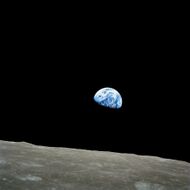
During the summer of 1968, the Apollo program hit another snag: the first pilot-rated Lunar Module (LM) was not ready for orbital tests in time for a December 1968 launch. NASA planners overcame this challenge by changing the mission flight order, delaying the first LM flight until March 1969, and sending Apollo 8 into lunar orbit without the LM in December.[170] This mission was in part motivated by intelligence rumors the Soviet Union might be ready for a piloted Zond flight in late 1968.[171] In September 1968, Zond 5 made a circumlunar flight with tortoises on board and returned safely to Earth, accomplishing the first successful water landing of the Soviet space program in the Indian Ocean.[172] It also scared NASA planners, as it took them several days to figure out that it was only an automated flight, not piloted, because voice recordings were transmitted from the craft en route to the Moon.[173] On November 10, 1968, another automated test flight, Zond 6, was launched. It encountered difficulties in Earth reentry, and depressurized and deployed its parachute too early, causing it to crash-land only 16 kilometers (9.9 mi) from where it had been launched six days earlier.[174] It turned out there was no chance of a piloted Soviet circumlunar flight during 1968, due to the unreliability of the Zonds.[175]
On December 21, 1968, Frank Borman, James Lovell, and William Anders became the first humans to ride the Saturn V rocket into space, on Apollo 8. They also became the first to leave low-Earth orbit and go to another celestial body, entering lunar orbit on December 24.[176] They made ten orbits in twenty hours, and transmitted one of the most watched TV broadcasts in history, with their Christmas Eve program from lunar orbit, which concluded with a reading from the biblical Book of Genesis.[176] Two and a half hours after the broadcast, they fired their engine to perform the first trans-Earth injection to leave lunar orbit and return to the Earth.[176] Apollo 8 safely landed in the Pacific Ocean on December 27, in NASA's first dawn splashdown and recovery.[176]
The American Lunar Module was finally ready for a successful piloted test flight in low Earth orbit on Apollo 9 in March 1969. The next mission, Apollo 10, conducted a "dress rehearsal" for the first landing in May 1969, flying the LM in lunar orbit as close as 47,400 feet (14.4 km) above the surface, the point where the powered descent to the surface would begin.[177] With the LM proven to work well, the next step was to attempt the landing.
Unknown to the Americans, the Soviet Moon program was in deep trouble.[175] After two successive launch failures of the N1 rocket in 1969, Soviet plans for a piloted landing suffered delay.[178] The launch pad explosion of the N-1 on July 3, 1969, was a significant setback.[179] The rocket hit the pad after an engine shutdown, destroying itself and the launch facility.[179] Without the N-1 rocket, the USSR could not send a large enough payload to the Moon to land a human and return him safely.[180]
First humans on the Moon
Apollo 11 was prepared with the goal of a July landing in the Sea of Tranquility.[181] The crew, selected in January 1969, consisted of commander (CDR) Neil Armstrong, Command Module Pilot (CMP) Michael Collins, and Lunar Module Pilot (LMP) Edwin "Buzz" Aldrin.[182] They trained for the mission until just before the launch day.[183] On July 16, 1969, at 9:32 am EDT, the Saturn V rocket, AS-506, lifted off from Kennedy Space Center Launch Complex 39 in Florida.[184]
The trip to the Moon took just over three days.[185] After achieving orbit, Armstrong and Aldrin transferred into the Lunar Module named Eagle, leaving Collins in the Command and Service Module Columbia, and began their descent. Despite the interruption of alarms from an overloaded computer caused by an antenna switch left in the wrong position, Armstrong took over manual flight control at about 180 meters (590 ft) to correct a slight downrange guidance error, and set the Eagle down on a safe landing spot at 20:18:04 UTC, July 20, 1969 (3:17:04 pm CDT). Six hours later, at 02:56 UTC, July 21 (9:56 pm CDT July 20), Armstrong left the Eagle to become the first human to set foot on the Moon.[186]
The first step was witnessed on live television by at least one-fifth of the population of Earth, or about 723 million people.[187] His first words when he stepped off the LM's landing footpad were, "That's one small step for [a] man, one giant leap for mankind."[186] Aldrin joined him on the surface almost 20 minutes later.[188] Altogether, they spent just under two and one-quarter hours outside their craft.[189] The next day, they performed the first launch from another celestial body, and rendezvoused back with Collins in Columbia.[190]
Apollo 11 left lunar orbit and returned to Earth, landing safely in the Pacific Ocean on July 24, 1969.[191] When the spacecraft splashed down, 2,982 days had passed since Kennedy's commitment to landing a man on the Moon and returning him safely to the Earth before the end of the decade; the mission was completed with 161 days to spare.[192] With the safe completion of the Apollo 11 mission, the Americans won the race to the Moon.[193]
Armstrong and his crew became worldwide celebrities, feted with ticker-tape parades on August 13 in New York City and Chicago, attended by an estimated six million.[194][195] That evening in Los Angeles they were honored at an official state dinner attended by members of Congress, 44 governors, the Chief Justice of the United States, and ambassadors from 83 nations. The President and Vice president presented each astronaut with the Presidential Medal of Freedom.[194][196] The astronauts spoke before a joint session of Congress on September 16, 1969.[197] This began a 38-day world tour to 22 foreign countries and included visits with the leaders of many countries.[198]
The public's reaction in the Soviet Union was mixed. The Soviet government limited the release of information about the lunar landing, which affected the reaction. A portion of the populace did not give it any attention, and another portion was angered by it.[199]
The first landing was followed by another, precision landing on Apollo 12 in November 1969, within walking distance of the Surveyor 3 spacecraft which landed on April 20, 1967.
Competition ramps down
NASA had ambitious follow-on human spaceflight plans as it reached its lunar goal but soon discovered it had expended most of its political capital to do so.[200] A victim of its own success, Apollo had achieved its first landing goal with enough spacecraft and Saturn V launchers left for a total of ten lunar landings through Apollo 20, conducting extended-duration missions and transporting the landing crews in Lunar Roving Vehicles on the last five. NASA also planned an Apollo Applications Program (AAP) to develop a longer-duration Earth orbital workshop (later named Skylab) from a spent S-IVB upper stage, to be constructed in orbit using several launches of the smaller Saturn IB launch vehicle.
In February 1969, President Richard M. Nixon convened a "space task group" to set recommendations for the future US civilian space program, headed by his vice president, Spiro T. Agnew.[201] Agnew was an enthusiastic proponent of NASA's follow-up plans for permanent space stations in Earth and lunar orbit, perhaps a base on the lunar surface, and the first human flight to Mars as early as 1986 or as late as 2000.[202] These would be serviced by an infrastructure of a reusable Space Transportation System, including an Earth-to-orbit Space Shuttle. Nixon had a better sense of the declining political support in Congress for new Apollo-style programs, which had disappeared with the achievement of the landing, and he intended to pursue détente with the USSR and China, which he hoped might ease Cold War tensions. He cut the spending proposal he sent to Congress to include funding for only the Space Shuttle, with perhaps an option to pursue the Earth orbital space station for the foreseeable future.[203]
AAP planners decided the Earth orbital workshop could be accomplished more efficiently by prefabricating it on the ground and launching it with a single Saturn V, which immediately eliminated Apollo 20. Budget cuts soon led NASA to cut Apollo 18 and 19 as well. Apollo 13 had to abort its lunar landing in April 1970 due to an in-flight spacecraft failure but returned its crew safely to Earth. The Apollo program made its final lunar landing in December 1972; the two unused Saturn Vs were used as outdoor visitor displays and allowed to deteriorate due to the effects of weathering.
The USSR continued trying to develop its N1 rocket, after two more launch failures in 1971 and 1972, finally canceling it in May 1974, without achieving a single successful uncrewed test flight.[204]
Salyuts and Skylab
Having lost the race to the Moon, the USSR decided to concentrate on orbital space stations. During 1969 and 1970, they launched six more Soyuz flights after Soyuz 3 and then launched a series of six successful space stations (plus two failures to achieve orbit and one station rendered uninhabitable due to damage from explosion of the launcher's upper stage) on their Proton-K heavy-lift launcher in their Salyut program designed by Kerim Kerimov. Each one weighed between 18,500 and 19,824 kilograms (40,786 and 43,704 lb), was 20 meters (66 ft) long by 4 meters (13 ft) in diameter, and had a habitable volume of 99 cubic meters (3,500 cu ft). All of the Salyuts were presented to the public as non-military scientific laboratories, but three of them were covers for military Almaz reconnaissance stations: Salyut 2 (failed),[205] Salyut 3,[206] and Salyut 5.[citation needed]
Salyut 1, the first space station, was launched by the Soviets on April 19, 1971. Three days later, the Soyuz 10 crew attempted to dock with it, but failed to achieve a secure enough connection to safely enter the station. The Soyuz 11 crew of Vladislav Volkov, Georgi Dobrovolski and Viktor Patsayev successfully docked on June 7, and completed a record 22-day stay. The crew became the second in-flight space fatality during their reentry on June 30. They were asphyxiated when their spacecraft's cabin lost all pressure, shortly after undocking. The disaster was blamed on a faulty cabin pressure valve, that allowed all the air to vent into space. The crew was not wearing pressure suits and had no chance of survival once the leak occurred.[207]
The United States launched a single orbital workstation, Skylab, on May 14, 1973. It weighed 169,950 pounds (77,090 kg), was 58 feet (18 m) long by 21.7 feet (6.6 m) in diameter, and had a habitable volume of 10,000 cubic feet (280 m3). Skylab was damaged during the ascent to orbit, losing one of its solar panels and a meteoroid thermal shield. Subsequent crewed missions repaired the station, and the third and final mission's crew, Skylab 4, set a human endurance record (at the time) with 84 days in orbit when the mission ended on February 8, 1974. Skylab stayed in orbit another five years before reentering the Earth's atmosphere over the Indian Ocean and Western Australia on July 11, 1979.[208]
Salyut 4 broke Skylab's occupation record at 92 days. Salyut 6 and Salyut 7 were second-generation stations designed for long duration, and were occupied for 683 and 816 days.
Apollo–Soyuz Test Project
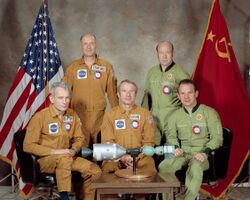

In May 1972, President Richard M. Nixon and Soviet Premier Leonid Brezhnev negotiated an easing of relations known as détente, creating a temporary "thaw" in the Cold War. The two nations planned a joint mission to dock the last US Apollo craft with a Soyuz, known as the Apollo-Soyuz Test Project (ASTP). To prepare, the US designed a docking module for the Apollo that was compatible with the Soviet docking system, which allowed any of their craft to dock with any other (e.g. Soyuz-to-Soyuz as well as Soyuz-to-Salyut). The module was also necessary as an airlock to allow the men to visit each other's craft, which had incompatible cabin atmospheres. The USSR used the Soyuz 16 mission in December 1974 to test modifications of the Soyuz atmosphere and the docking adapter to prepare for ASTP.[209][210]
The joint mission began when Soyuz 19 was first launched on July 15, 1975, at 12:20 UTC, and the Apollo craft was launched with the docking module six and a half hours later. The two craft rendezvoused and docked on July 17 at 16:19 UTC. The three astronauts conducted joint experiments with the two cosmonauts, and the crew shook hands, exchanged gifts, and visited each other's craft.[211]
Space Shuttles
NASA achieved the first approach and landing test of its Space Shuttle orbiter on a Boeing 747 carrier plane on August 12, 1977, and the first orbital test flight of a complete, crewed Space Shuttle, consisting of the orbiter, an external fuel tank, and two solid rocket boosters, on April 12, 1981. The designers underestimated the time and cost of refurbishment between flights, which reduced the cost benefit of its reusability. They also overestimated its safety: two of the fleet of five orbiters were lost in fatal flight accidents: one during launch, due to failure of a solid rocket booster seal; and one on reentry, due to launch damage of a wing heat shield. The Air Force was also supposed to use the Shuttle to launch its military payloads, but shunned it in favor of its expendable launchers after the first Shuttle loss. NASA ceased production of its Apollo spacecraft and Saturn IB launcher, and used the Shuttle as its orbital workhorse until 2011, then retired it due to the safety concern. Originally, more than 150 flights over a 15-year operation were expected; actually, the Shuttle made 135 flights in its 30-year lifespan.
The Soviets mistook the Shuttle as a military surveillance vehicle and decided they had to develop their own shuttle, which they named Buran, beginning in 1974. They copied the aerodynamic design of NASA's Shuttle orbiter, which they strapped to the side of their expendable, liquid hydrogen-fueled Energia launcher. The Buran could be fitted with four Saturn AL-31 turbofan engines and a fuel tank in its payload bay, allowing it to make its own atmospheric test flights, which began in November 1985. Also unlike the US Shuttle, it could be flown pilotlessly and landed automatically. Energia-Buran made only one orbital test flight in November 1988, but US counterintelligence baited the Soviets with disinformation about the heat shield design, and it was not reusable for repeated flight.[212] Buran was the largest and most expensive Soviet program in the history of the Space Race,[213] and was effectively canceled by the collapse of the Soviet Union in 1991, due to lack of funding. The Energia was also canceled at the same time, after only two flights.
First professional women in space
The first woman in space was from the Soviet Union, Valentina Tereshkova. NASA did not welcome female astronauts into its corps until 1978, when six female mission specialists were recruited. This first class included scientist Sally Ride, who became America's first woman in space on STS-7 in June 1983. NASA included women mission specialists in the next four astronaut candidate classes, and admitted female pilots starting in 1990. Eileen Collins from this class became the first pilot to fly on Space Shuttle flight STS-63 in February 1995, and the first female commander of a spaceflight on STS-93 in July 1999.
The USSR admitted its first female test pilot as a cosmonaut, Svetlana Savitskaya, in 1980. She became the first female to fly since Tereshkova, on Salyut 7 in December 1981.
First modular space station
The USSR turned its space program to the development of the low Earth orbit modular space station Mir (peace or world) assembled in orbit from 1986 to 1996. At 129,700 kilograms (285,900 lb), it held records for the largest spacecraft and the longest continuous human presence in space at 3,644 days, until the International Space Station was built starting in 1998.[214] Mir's operation continued after the 1991 replacement of the USSR's space program with the Russian Federal Space Agency until 2001, supported by Soyuz spacecraft.
Legacy
According to American political scientist Richard J. Samuels, the space race is generally regarded as a "decisive American victory" after Apollo 11.[9] However, according to historian Jennifer Frost, "[i]f we define the 'space race' as spaceflight capability, the Soviets won it hands down".[10] Space historian Asif A. Siddiqi proposes more nuanced view:[11]
Before that landing [Apollo 11], there was an enormous amount of investment in the robotic exploration of the Moon, both by the Soviets and the US, in terms of all sorts of smaller benchmarks like the first lunar impact, the first pictures of the far side of the Moon, the first soft lunar landing, and the first lunar orbit. We forget, but in those little races, the Soviet Union dominated almost every benchmark, but it is forgotten as the United States won the big one.
After the end of the Cold War in 1991, the assets of the USSR's space program passed mainly to Russia. Since then, the United States and Russia have cooperated in space with the Shuttle-Mir Program, and the International Space Station (ISS).[215] The Russians continue to use their R-7 rocket family as their orbital workhorse to launch the Soyuz crewed spacecraft and its Progress derivative uncrewed cargo craft as shuttles to the ISS. After the 2011 retirement of the Space Shuttle, American crews were dependent on the R-7–Soyuz to reach the ISS,[216] until the 2020 first flight of the US Crew Dragon Commercial Crew Development vehicle.
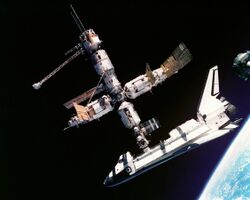
See also
- Billionaire space race
- Cold War
- Arms race
- Cold War playground equipment
- History of spaceflight
- List of space exploration milestones, 1957–1969
- Moon landing
- Moon Shot
- Space advocacy
- Space exploration
- Space policy
- Space propaganda
- Spaceflight records
- SEDS
- Timeline of Solar System exploration
- Timeline of space exploration
- Woods Hole Conference
- Mars race
References
- ↑ "The Space Race". History.com. February 21, 2020. https://www.history.com/topics/cold-war/space-race.
- ↑ "How Did NASA'S "Vomit Comet" Get Its Name? A Brief History". June 30, 2023. https://www.gozerog.com/article/nasa-vomit-comet/. "A Soviet youth magazine in 1951 is often credited with sparking public interest in space travel. Quickly picked up by US magazines, the idea of extending the Cold War playing board to outer space soon energized the imaginations of politicians, military leaders, and the private sector."
- ↑ 3.0 3.1 3.2 3.3 3.4 Schefter 1999, pp. 3–5.
- ↑ 4.0 4.1 Siddiqi 2003a, p. 460.
- ↑ 5.0 5.1 Kennedy, John F. (May 25, 1961). Special Message to Congress on Urgent National Needs (Motion picture (excerpt)). Boston, MA: John F. Kennedy Presidential Library and Museum. Accession Number: TNC:200; Digital Identifier: TNC-200-2. Retrieved August 1, 2013.
- ↑ "Apollo 11 Command and Service Module (CSM)". https://nssdc.gsfc.nasa.gov/nmc/spacecraft/display.action?id=1969-059A.
- ↑ "Apollo 11 Lunar Module / EASEP". https://nssdc.gsfc.nasa.gov/nmc/spacecraft/display.action?id=1969-059C.
- ↑ "Apollo 11 Mission Summary". https://airandspace.si.edu/explore-and-learn/topics/apollo/apollo-program/landing-missions/apollo11.cfm.
- ↑ 9.0 9.1 9.2 Both the Apollo 11 Moon landing and the ASTP have been identified as the end of the Space Race,Samuels, Richard J., ed (2005). Encyclopedia of United States National Security (1st ed.). SAGE Publications. p. 669. ISBN 978-0-7619-2927-7. https://books.google.com/books?id=K751AwAAQBAJ&pg=PT747. "Most observers felt that the U.S. moon landing ended the space race with a decisive American victory. […] The formal end of the space race occurred with the 1975 joint Apollo-Soyuz mission, in which U.S. and Soviet spacecraft docked, or joined, in orbit while their crews visited one another's craft and performed joint scientific experiments."
- ↑ 10.0 10.1 Frost, Jennifer (July 18, 2019). "Who really won the US-Soviet space race?". https://newsroom.co.nz/2019/07/18/who-really-won-the-us-soviet-space-race/.
- ↑ 11.0 11.1 "Calls For a New Way of Thinking About the Global Space Race - SPACE & DEFENSE". 29 June 2023. https://spaceanddefense.io/calls-for-a-new-way-of-thinking-about-the-global-space-race/.
- ↑ Williams, David R. (December 11, 2003). "Apollo Landing Site Coordinates". NASA Space Science Data Coordinated Archive. NASA. http://nssdc.gsfc.nasa.gov/planetary/lunar/lunar_sites.html.
- ↑ 13.0 13.1 U.S.-Soviet Cooperation in Space (Report). US Congress, Office of Technology Assessment. July 1985. pp. 80–81. https://www.princeton.edu/~ota/disk2/1985/8533/8533.PDF. Retrieved June 13, 2018.
- ↑ Boyle, Alan (March 23, 2001). "Russia bids farewell to Mir". NBC News (New York). http://www.nbcnews.com/id/3077781/ns/technology_and_science-space/t/russia-bids-farewell-mir/#.VXyY2BNVhHw.
- ↑ Garcia, Mark (April 30, 2015). "ISS Facts and Figures". International Space Station. NASA. http://www.nasa.gov/mission_pages/station/main/onthestation/facts_and_figures.html.
- ↑ Neufeld, Michael J (1995). The Rocket and the Reich: Peenemünde and the Coming of the Ballistic Missile Era. New York: The Free Press. pp. 158, 160–62, 190. ISBN 978-0-02-922895-1. https://archive.org/details/isbn_9780029228951.
- ↑ Siddiqi 2000, p. 89.
- ↑ Schmitz 1999, pp. 149–54.
- ↑ Siddiqi 2000, p. 6.
- ↑ Chertok 2005, p. 164-5 Vol 1.
- ↑ Chertok 2005, p. 165 Vol 1.
- ↑ Siddiqi 2000, p. 4-5.
- ↑ "GIRD (Gruppa Isutcheniya Reaktivnovo Dvisheniya)". http://weebau.com/rock_rus/gird.htm.
- ↑ Zak, Anatoly. "Gas Dynamics Laboratory". http://www.russianspaceweb.com/gdl.html.
- ↑ Chertok 2005, p. 167 vol 1.
- ↑ "Greatest World War II Weapons: The Fearsome Katyusha Rocket Launcher". February 20, 2016. https://defencyclopedia.com/2016/02/20/greatest-world-war-ii-weapons-the-fearsome-katyusha-rocket-launcher/.
- ↑ Siddiqi 2000, p. 9.
- ↑ Chertok 2005, p. 167-8 Vol 1.
- ↑ Siddiqi 2000, p. 24-39.
- ↑ Chertok 2005, p. 41 Vol 2.
- ↑ Siddiqi 2000, p. 49.
- ↑ Zaloga, Steven J. (20 March 2013). V-2 Ballistic Missile 1942–52. Bloomsbury Publishing. p. 41. ISBN 978-1-4728-0299-6. https://books.google.com/books?id=gS8VDAAAQBAJ&pg=PA41.
- ↑ Zaloga, Steven J. (20 March 2013). "R-11: the Scud A". Scud Ballistic Missile and Launch Systems 1955–2005. Bloomsbury Publishing. pp. 6–15. ISBN 978-1-4728-0306-1. https://books.google.com/books?id=8X-HCwAAQBAJ&pg=PT6.
- ↑ Siddiqi 2000, p. 42.
- ↑ Chertok 2005, p. 48-49 Vol 2.
- ↑ Chertok 2005, p. 242-285 Vol 2.
- ↑ Brian Harvey; Olga Zakutnyaya (2011). Russian Space Probes: Scientific Discoveries and Future Missions. Chichester,UK: Springer Praxis Books. OCLC 1316077842.
- ↑ Siddiqi 2000, p. 128-132.
- ↑ 39.0 39.1 "The Military Rockets that Launched the Space Age". https://airandspace.si.edu/stories/editorial/military-rockets-launched-space-age.
- ↑ Siddiqi 2000, p. 160-161.
- ↑ "Russian Rockets and Space Launchers". https://historicspacecraft.com/Rockets_Russian.html.
- ↑ Zak, Anatoly. "The R-7 intercontinental ballistic missile". https://www.russianspaceweb.com/r7.html.
- ↑ Schefter 1999, p. 29.
- ↑ Burrows 1998, p. 123.
- ↑ 45.0 45.1 Burrows 1998, pp. 129–34.
- ↑ 46.0 46.1 46.2 Burrows 1998, p. 137.
- ↑ 47.0 47.1 47.2 47.3 Wade, Mark. "Atlas". Encyclopedia Astronautix. http://www.astronautix.com/a/index.html. Retrieved September 28, 2020.
- ↑ Koman, Rita G. (January 1, 1994). "Man on the Moon: The U.S. Space Program as a Cold War Maneuver". OAH Magazine of History 8 (2): 42–50. doi:10.1093/maghis/8.2.42.
- ↑ 49.0 49.1 49.2 49.3 Andrews, James T.; Siddiqi, Asif A. (2011). Into the Cosmos: Space Exploration and Soviet Culture. University of Pittsburgh Pre. ISBN 978-0-8229-7746-9. https://books.google.com/books?id=W7oRuOZbb8IC. Retrieved 2016-01-19.
- ↑ 50.0 50.1 "OhioLINK Institution Selection". http://ebooks.ohiolink.edu/xtf-ebc/view?docId=tei/sv2/9781461430520/9781461430520.xml&query=&brand=default.
- ↑ 51.0 51.1 Schefter 1999, p. 8.
- ↑ Schefter 1999, p. 6.
- ↑ 53.0 53.1 53.2 Schefter 1999, pp. 15–18.
- ↑ 54.0 54.1 Cadbury 2006, pp. 154–57.
- ↑ 55.0 55.1 Siddiqi 2003a, p. 151.
- ↑ Siddiqi 2003a, p. 155.
- ↑ Garber, Steve (October 10, 2007). "Sputnik and The Dawn of the Space Age". Sputnik 50th Anniversary. Washington: NASA History Website. https://history.nasa.gov/sputnik/.
- ↑ Hardesty & Eisman 2007, pp. 72–73.
- ↑ 59.0 59.1 59.2 Siddiqi 2003a, pp. 163–68.
- ↑ 60.0 60.1 60.2 Cadbury 2006, p. 163.
- ↑ 61.0 61.1 Hardesty & Eisman 2007, p. 74.
- ↑ Cadbury 2006, pp. 164–65.
- ↑ "Analysis of Soviet Earth Satellite and Launching Device". 1957-11-09. https://www.cia.gov/readingroom/docs/DOC_0000124270.pdf.
- ↑ Mark Wade. "Atlas A". Encyclopedia Astronautica. http://www.astronautix.com/a/atlasa.html. Retrieved 2022-11-01.
- ↑ Gröttrup, Helmut (April 1958) (in de). Aus den Arbeiten des deutschen Raketen-Kollektivs in der Sowjet-Union.. Raketentechnik und Raumfahrtforschung. Deutsche Gesellschaft für Raketentechnik und Raumfahrt. pp. 58–62. "Towards the end of the war the general opinion was that a starting acceleration of 2 g was optimal. We have carried out detailed studies on this point, taking into account the increase in engine weights and the weights of the components used to transmit thrust. It turned out that a starting acceleration of a considerably smaller value can be optimal. One of our projects was designed for a starting acceleration of 1.4 g."
- ↑ "Development of guided missiles at Bleicherode and Institut 88". CIA Historical Collections. 1954-01-22. https://archive.org/details/CIA-RDP80-00810A003300530005-2. "It was generally held up to now that the ratio thrust/take-off weights should be approximately two. [Gröttrup] discovered … that values as low as 1.2 for this ratio could give optimum results under certain conditions." Remark: The designations R-12 und R-14 are related to the internal project names (also known as G-2 und G-4), not to the rockets installed during the Cuban Missile Crisis
- ↑ Crompton, Samuel (2007). Sputnik/Explorer I: The Race to Conquer Space. New York City: Chelsea House Publications. p. 4. ISBN 978-0-7910-9357-3.
- ↑ Brzezinski 2007, pp. 254–67.
- ↑ 69.0 69.1 O'Neill, Terry. The Nuclear Age. San Diego: Greenhaven, Inc., 2002.(146)
- ↑ Knapp, Brian. Journey into Space. Danbury: Grolier, 2004.(17)
- ↑ Barnett, Nicholas. '"Russia Wins Space Race": The British Press and the Sputnik Moment', Media History, (2013) 19:2, 182–95.
- ↑ "THE NATION: Red Moon Over the U.S.". TIME. 1957-10-14. http://www.time.com/time/magazine/article/0,9171,862748,00.html.
- ↑ 73.0 73.1 73.2 Nicogossian, Arnauld E. (1993). Space Biology and Medicine: Space and Its Exploration. Washington, DC.: American Institute of Aeronautics. p. 285.
- ↑ Angelo, Joseph, A. (2006). Encyclopedia of Space Astronomy. New York: Facts on Files, Inc.. p. 634. ISBN 978-0-8160-5330-8. https://archive.org/details/encyclopediaofsp0000ange.
- ↑ Angelo, Joseph, A. (2006). Encyclopedia of Space Astronomy. New York: Facts on Files, Inc.. p. 225. ISBN 978-0-8160-5330-8. https://archive.org/details/encyclopediaofsp0000ange.
- ↑ "Birth of NASA". https://history.nasa.gov/SP-4201/ch4-6.htm.
- ↑ Bilstein, Roger E.. "2. Aerospace Alphabet: ABMA, ARPA, MSFC". Stages to Saturn. Washington D.C.: NASA. p. 39. https://history.nasa.gov/SP-4206/ch2.htm. Retrieved March 19, 2021.
- ↑ Siddiqi 2018, p. xv.
- ↑ Siddiqi 2018, p. 14.
- ↑ "Pioneer 0, 1, 2". http://msl.jpl.nasa.gov/QuickLooks/pioneer0QL.html.
- ↑ Hess, Wilmot (1968). The Radiation Belt and Magnetosphere.
- ↑ Siddiqi 2018, p. 41.
- ↑ "National Space Science Data Center – Ranger 6". National Air and Space Administration. https://nssdc.gsfc.nasa.gov/nmc/spacecraft/display.action?id=1964-007A.
- ↑ "The Beginnings of Research in Space Biology at the Air Force Missile Development Center, 1946-1952". NASA. January 1958. https://history.nasa.gov/afspbio/part1.htm.
- ↑ DE Beischer and AR Fregly (1962). "Animals and man in space. A chronology and annotated bibliography through the year 1960.". US Naval School of Aviation Medicine ONR TR ACR-64 (AD0272581). http://archive.rubicon-foundation.org/9288. Retrieved 14 June 2011.
- ↑ "First dog in space died within hours". BBC. 28 October 2002. http://news.bbc.co.uk/2/hi/sci/tech/2367681.stm.
- ↑ Berger, Eric (3 November 2017). "The first creature in space was a dog. She died miserably 60 years ago". Ars Technica. https://arstechnica.com/science/2017/11/sixty-years-ago-the-first-creature-went-into-space-a-stray-moscow-dog/.
- ↑ Dick Abadzis, afterword to Laika, First Second, 2007, ISBN:1-59643-302-7
- ↑ "Chimp survives 420-mile ride into space". Lewiston Morning Tribune. Associated Press (Idaho): p. 1. February 1, 1961. https://news.google.com/newspapers?id=SYNfAAAAIBAJ&pg=4039%2C4654.
- ↑ "Chimp sent out on flight over Atlantic". The Bulletin. UPI (Bend, Oregon): p. 1. January 31, 1961. https://news.google.com/newspapers?id=wVFYAAAAIBAJ&pg=3503%2C5627337.
- ↑ "Operational Trouble Shortens Chimp's Ride". The Daily Advertiser. Associated Press (Lafayette, Louisiana): p. 1. November 29, 1961. https://www.newspapers.com/clip/32507843/the_daily_advertiser/.
- ↑ Animals In Space: From Research Rockets to the Space Shuttle, Chris Dubbs and Colin Burgess, 2007
- ↑ Asif Siddiqi (12 October 2015). "Declassified documents offer a new perspective on Yuri Gagarin's flight". https://www.thespacereview.com/article/2844/1.
- ↑ 94.0 94.1 94.2 Hall & Shayler 2001, pp. 149–57.
- ↑ Gatland 1976, p. 254.
- ↑ Pervushin (2011), 7.1 Гражданин мира
- ↑ Государственная Дума. Федеральный закон №32-ФЗ от 13 марта 1995 г. «О днях воинской славы и памятных датах России», в ред. Федерального закона №59-ФЗ от 10 апреля 2009 г «О внесении изменения в статью 1.1 федерального закона "О днях воинской славы и памятных датах России"». Вступил в силу со дня официального опубликования. Опубликован: "Российская Газета", №52, 15 марта 1995 г. (State Duma. Federal Law #32-FZ of March 13, 1995 On the Days of Military Glory and the Commemorative Dates in Russia, as amended by the Federal Law #59-FZ of April 10, 2009 On Amending Article 1.1 of the Federal Law "On the Days of Military Glory and the Commemorative Dates in Russia". Effective as of the day of the official publication.).
- ↑ "UN Resolution A/RES/65/271, The International Day of Human Space Flight (12 April)". April 7, 2011. https://www.un.org/en/events/humanspaceflightday/.
- ↑ Hall & Shayler 2001, pp. 183, 192.
- ↑ Gatland 1976, pp. 117–18.
- ↑ Hall & Shayler 2001, pp. 185–91.
- ↑ 102.0 102.1 Hall & Shayler 2001, pp. 194–218.
- ↑ "Kamanin diaries, April 16, 1965". Astronautix.com. http://www.astronautix.com/k/kamanindiaries.html.
- ↑ Burgess & Hall 2009, p. 229.
- ↑ Eidelman, Tamara (2013). "A Cosmic Wedding". Russian Life 56 (6): 22–25.
- ↑ Nikolaeva-Tereshkova, Valentina Vladimirovna (2015). "Preface". The 'First Lady of Space': In Her Own Words. Bethesda, MD: SpaceHistory101.com Press. pp. 4–7. ISBN 978-1-887022-99-6. OCLC 930799309.
- ↑ Catchpole 2001, p. 150.
- ↑ Catchpole 2001, p. 131.
- ↑ Swenson, Grimwood & Alexander 1966, p. 47.
- ↑ Swenson, Grimwood & Alexander 1966, p. 490.
- ↑ Schefter 1999, pp. 138–43.
- ↑ Gatland 1976, pp. 153–54.
- ↑ As World Watched. Spaceman Hailed After U.S. Triumph, 1961/05/08 (1961) (Motion picture). Universal-International Newsreel. 1961. OCLC 709678549. Retrieved February 20, 2012.
- ↑ Neuman, Scott (2021-07-22). "A New Analysis May Have Just Solved A Decades-Old Mystery Of The Space Race" (in en). NPR. https://www.npr.org/2021/07/22/1019254674/gus-grissom-liberty-bell-mercury-the-right-stuff.
- ↑ 115.0 115.1 Schefter 1999, pp. 156–164.
- ↑ "President John F. Kennedy Pins NASA Distinguished Service Medal on John Glenn". NASA. May 13, 2015. https://www.nasa.gov/image-feature/president-john-f-kennedy-pins-nasa-distinguished-service-medal-on-john-glenn.
- ↑ Catchpole, John (2001). Project Mercury – NASA's First Manned Space Programme. Chichester, UK: Springer Praxis. pp. 385–386. ISBN 1-85233-406-1. https://archive.org/details/projectmercuryna0000catc.
- ↑ Quoted in John M. Logsdon, The Decision to Go to the Moon: Project Apollo and the National Interest (Cambridge, MA: MIT Press, 1970) p. 111.
- ↑ David E. Bell, Memorandum for the President, "National Aeronautics and Space Administration Budget Problem", March 22, 1961, NASA Historical Reference Collection; U.S. Congress, House, Committee of Science and Astronautics, NASA Fiscal 1962 Authorization, Hearings, 87th Cong., 1st. sess., 1962, pp. 203, 620; Logsdon, Decision to go to the Moon, pp. 94–100.
- ↑ Wolfe, Tom. The Right Stuff. New York: Picador, 1979.(179)
- ↑ Roger D. Launius and Howard E. McCurdy, eds, Spaceflight and the Myth of Presidential Leadership (Champaign, IL: University of Illinois Press, 1997), 56.
- ↑ Kennedy to Johnson,"Memorandum for Vice President," April 20, 1961.
- ↑ von Braun, Wernher (April 29, 1961). "Memo, Wernher von Braun to the Vice President of the United States". NASA. http://www.hq.nasa.gov/office/pao/History/Apollomon/apollo3.pdf.
- ↑ Johnson, Lyndon B. (April 28, 1961). "Memo, Johnson to Kennedy, Evaluation of Space Program". https://www.hq.nasa.gov/office/pao/History/Apollomon/apollo2.pdf.
- ↑ 125.0 125.1 Kennedy, John F. (September 12, 1962). "Address at Rice University on the Nation's Space Effort". Historical Resources. John F. Kennedy Presidential Library and Museum. http://www.jfklibrary.org/Historical+Resources/Archives/Reference+Desk/Speeches/JFK/003POF03SpaceEffort09121962.htm.
- ↑ Engvold, Oddbjørn; Czerny, Bozena; Lattanzio, John; Stabell, Rolf (30 November 2012). Astronomy and Astrophysics – Volume I. Encyclopedia of Life Support Systems (EOLSS). pp. 228–. ISBN 978-1-78021-000-1. https://books.google.com/books?id=DXgvCwAAQBAJ&pg=PA228.
- ↑ "Address before the 18th General Assembly of the United Nations, September 20, 1963". 1963-09-20. https://www.jfklibrary.org/archives/other-resources/john-f-kennedy-speeches/united-nations-19630920. ""Finally, in a field where the United States and the Soviet Union have a special capacity—in the field of space—there is room for new cooperation, for further joint efforts in the regulation and exploration of space. I include among these possibilities a joint expedition to the moon. Space offers no problems of sovereignty; by resolution of this Assembly, the members of the United Nations have foresworn any claim to territorial rights in outer space or on celestial bodies, and declared that international law and the United Nations Charter will apply. Why, therefore, should man's first flight to the moon be a matter of national competition? Why should the United States and the Soviet Union, in preparing for such expeditions, become involved in immense duplications of research, construction, and expenditure? Surely we should explore whether the scientists and astronauts of our two countries—indeed of all the world—cannot work together in the conquest of space, sending someday in this decade to the moon not the representatives of a single nation, but the representatives of all of our countries.""
- ↑ Stone, Oliver and Peter Kuznick, "The Untold History of the United States" (Gallery Books, 2012), p. 320
- ↑ 129.0 129.1 Sietzen, Frank (October 2, 1997). "Soviets Planned to Accept JFK's Joint Lunar Mission Offer". "SpaceCast News Service" Washington DC. http://www.spacedaily.com/news/russia-97h.html.
- ↑ Sagdeev, Roald; Eisenhower, Susan (28 May 2008). "United States-Soviet Space Cooperation during the Cold War". http://www.nasa.gov/50th/50th_magazine/coldWarCoOp.html.
- ↑ Carl Sagan (September 1969). "The COSPAR Meetings in Prague". Icarus 11 (2): 268–272. doi:10.1016/0019-1035(69)90052-9. Bibcode: 1969Icar...11..268S.
- ↑ "Report on the Activities of the COSPAR Working Group VII". Prague, Czechoslovakia: National Academy of Sciences. 11–24 May 1969. p. 94.
- ↑ Loff, Sarah (2013-10-21). "Gemini: Stepping Stone to the Moon". Washington, DC: National Aeronautics and Space Administration. http://www.nasa.gov/mission_pages/gemini/#.VKi1GsaWt78.
- ↑ Siddiqi 2003a, p. 383.
- ↑ 135.0 135.1 135.2 Siddiqi 2003a, pp. 384–86.
- ↑ Schefter 1999, p. 149.
- ↑ Schefter 1999, p. 198.
- ↑ Special (October 13, 1964). "Space Troika on Target". The Toronto Star. UPI (Toronto: Torstar): p. 1.
- ↑ 139.0 139.1 Schefter 1999, pp. 199–200.
- ↑ 140.0 140.1 Tanner, Henry (March 19, 1965). "Russian Floats in Space for 10 Minutes; Leaves Orbiting Craft With a Lifeline; Moscow Says Moon Trip Is 'Target Now'". The New York Times (New York): p. 1. https://www.nytimes.com/learning/general/onthisday/big/0318.html?scp=2&sq=Voskhod%202&st=cse.
- ↑ Siddiqi 2003a, p. 448.
- ↑ 142.0 142.1 Schefter 1999, p. 205.
- ↑ 143.0 143.1 Siddiqi 2003a, pp. 454-460.
- ↑ Gayn, Mark (October 16, 1964). "Kremlin summit probably greased skids for Mr. K". The Toronto Star (Toronto: Torstar): p. 11.
- ↑ Siddiqi 2003a, pp. 510–11.
- ↑ Schefter 1999, p. 207.
- ↑ "The World's First Space Rendezvous". Apollo to the Moon; To Reach the Moon – Early Human Spaceflight. Smithsonian National Air and Space Museum. http://www.nasm.si.edu/exhibitions/attm/rm.ey.g7.3.html.
- ↑ Gatland 1976, p. 176.
- ↑ "Gemini8 Crew and PJs". http://www.nasaimages.org/luna/servlet/detail/nasaNAS~7~7~32671~136538:Gemini-8-crew-stands-on-deck-of-rec.
- ↑ 150.0 150.1 Portree 1995, p. 3.
- ↑ Harford, James (1997). Korolev: how one man masterminded the Soviet drive to beat America to the moon. New York; Chichester: Wiley. p. 271. ISBN 978-0-471-32721-9.
- ↑ "Ground Ignition Weights". https://history.nasa.gov/SP-4029/Apollo_18-19_Ground_Ignition_Weights.htm.
- ↑ Lindroos, Marcus. "The Soviet Manned Lunar Program". Federation of American Scientists (FAS). https://fas.org/spp/eprint/lindroos_moon1.htm.
- ↑ Heintze, Hans-Joachim (March 5, 1999). "Peaceful Uses of Outer Space and International Law". International Network of Engineers and Scientists Against Proliferation. http://www.inesap.org/bulletin17/bul17art22.htm.
- ↑ Google books Nuclear Weapons and Contemporary International Law N. Singh, E. WcWhinney (p. 289)
- ↑ UN website UN Resolution 1348 (XIII).
- ↑ "United Nations Committee on the Peaceful Uses of Outer Space". United Nations Office for Outer Space Affairs. http://www.unoosa.org/oosa/COPUOS/copuos.html.
- ↑ Papers of John F. Kennedy. Presidential Papers. National Security Files. Subjects. Space activities: US/USSR cooperation, 1961–96
- ↑ Treaty on Principles Governing the Activities of States in the Exploration and Use of Outer Space, including the Moon and Other Celestial Bodies: Status of the Treaty (UNODA)
- ↑ 160.0 160.1 160.2 Seamans, Robert C. Jr. (April 5, 1967). "Findings, Determinations And Recommendations". Report of Apollo 204 Review Board. NASA History Office. http://www.hq.nasa.gov/pao/History/Apollo204/find.html. Retrieved October 7, 2007.
- ↑ Slayton, Donald K.; Cassutt, Michael (1994). Deke!: U.S. Manned Space from Mercury to the Shuttle. New York City: Forge: St. Martin's Press. p. 223. ISBN 0-312-85503-6. OCLC 29845663. https://archive.org/details/dekeusmannedspac00slay. "It wasn't just a cut-and-dried decision as to who should make the first steps on the Moon. If I had to select on that basis, my first choice would have been Gus, which both Chris Kraft and Bob Gilruth seconded."
- ↑ Cadbury 2006, pp. 310–12, 314–16.
- ↑ Burrows (1999), p. 417
- ↑ Murray & Cox 1990, pp. 323–24.
- ↑ 165.0 165.1 165.2 165.3 Hall & Shayler 2003, pp. 144-47.
- ↑ "Soyuz 4 & 5: The First Crew Exchange in Space". January 17, 2019. https://www.drewexmachina.com/2019/01/17/soyuz-4-5-the-first-crew-exchange-in-space/.
- ↑ Williams, David R. (January 6, 2005). "Tentatively Identified Missions and Launch Failures". NASA NSSDC. http://nssdc.gsfc.nasa.gov/planetary/tent_launch.html.
- ↑ 168.0 168.1 Siddiqi 2003b, pp. 616-618.
- ↑ Hall & Shayler 2003, p. 25.
- ↑ Kraft 2001, pp. 284–97.
- ↑ Chaikin 1994, pp. 57–58.
- ↑ Siddiqi 2003b, pp. 654–56.
- ↑ Turnhill 2004, p. 134.
- ↑ Siddiqi 2003b, pp. 663–66.
- ↑ 175.0 175.1 Cadbury 2006, pp. 318–19.
- ↑ 176.0 176.1 176.2 176.3 Poole 2008, pp. 19–34.
- ↑ Brooks, Courtney G.; Grimwood, James M.; Swenson, Loyd S. Jr. (1979). "Apollo 10: The Dress Rehearsal". Chariots for Apollo: A History of Manned Lunar Spacecraft. NASA History Series. Foreword by Samuel C. Phillips. Washington, D.C.: Scientific and Technical Information Branch, NASA. NASA SP-4205. ISBN 978-0-486-46756-6. OCLC 4664449. http://www.hq.nasa.gov/office/pao/History/SP-4205/ch12-7.html. Retrieved January 29, 2008.
- ↑ Siddiqi 2003b, pp. 665, 832–34.
- ↑ 179.0 179.1 Siddiqi 2003b, pp. 690–93.
- ↑ Parry 2009, pp. 178–79.
- ↑ Parry 2009, pp. 144–51.
- ↑ Chaikin 1994, p. 138.
- ↑ Chaikin 1994, pp. 163–83.
- ↑ Parry 2009, pp. 38–44.
- ↑ Jones, Eric M. (January 1, 2010). "Apollo 11 Press Kit". Apollo Lunar Surface Journal. p. 33. http://www.hq.nasa.gov/alsj/a11/Apollo11_Press-Kit_restored.pdf.
- ↑ 186.0 186.1 Murray & Cox 1990, p. 356.
- ↑ Paterson, Chris (2010). "Space Program and television". The Museum of Broadcast Communications. http://www.museum.tv/eotvsection.php?entrycode=spaceprogram.
- ↑ Jones, Eric M. (January 1, 2010). "Apollo 11 Lunar Surface Journal". Apollo Lunar Surface Journal. p. MET 109:43:16. http://www.hq.nasa.gov/alsj/a11/a11.html.
- ↑ Jones, Eric M. (January 1, 2010). "Apollo 11 Lunar Surface Journal". Apollo Lunar Surface Journal. http://www.hq.nasa.gov/alsj/a11/a11.html. Mission elapsed time (MET) from when Armstrong states that he will step off the LM at 109hrs:24mins:13secs to when Armstrong was back inside the LM at 111hrs:38mins:38sec
- ↑ Parry 2009, pp. 250–51.
- ↑ Parry 2009, pp. 252–62.
- ↑ Murray & Cox 1990, p. 347.
- ↑ Schefter 1999, p. 288.
- ↑ 194.0 194.1 "Richard Nixon: Remarks at a Dinner in Los Angeles Honoring the Apollo 11 Astronauts". August 13, 1969. https://www.presidency.ucsb.edu/documents/remarks-dinner-los-angeles-honoring-the-apollo-11-astronauts.
- ↑ "President Offers Toast to 'Three Brave Men'". The Evening Sun. Associated Press (Baltimore, Maryland): p. 1. August 14, 1969. https://www.newspapers.com/clip/27531303/the_evening_sun/.
- ↑ Smith, Merriman (August 14, 1969). "Astronauts Awed by the Acclaim". The Honolulu Advertiser. UPI (Honolulu, Hawaii): p. 1. https://www.newspapers.com/clip/27531557/the_honolulu_advertiser/.
- ↑ "The Apollo 11 Crew Members Appear Before a Joint Meeting of Congress". United States House of Representatives. http://history.house.gov/HistoricalHighlight/Detail/35693.
- ↑ "Apollo 11 Crew Starts World Tour". Logan Daily News. Associated Press (Logan, Ohio): p. 1. September 29, 1969. https://www.newspapers.com/clip/27494178/the_logan_daily_news/.
- ↑ Das, Saswato R. (July 16, 2009). "The Moon Landing through Soviet Eyes: A Q&A with Sergei Khrushchev, son of former premier Nikita Khrushchev". Scientific American. https://www.scientificamerican.com/article/apollo-moon-khrushchev/. Retrieved January 7, 2019.
- ↑ Hepplewhite 1999, p. 186.
- ↑ Hepplewhite 1999, p. 123.
- ↑ Hepplewhite 1999, pp. 136–50.
- ↑ Hepplewhite 1999, pp. 150–77.
- ↑ Portree 1995, p. 5.
- ↑ "Salyut 2". Russian Space Web. http://www.russianspaceweb.com/almaz_ops1.html.
- ↑ James Bamford. "Astrospies". PBS Nova. https://www.pbs.org/wgbh/nova/astrospies/.
- ↑ "The Partnership: A History of the Apollo-Soyuz Test Project". NASA. 1974. https://history.nasa.gov/SP-4209/ch8-2.htm. "When the valve opened at a height of 168 kilometers, the gradual but steady loss of pressure was fatal to the crew within about 30 seconds."
- ↑ Lewis, Richard S. (1984). The Voyages of Columbia: The First True Spaceship. Columbia University Press. pp. 80–82. ISBN 0-231-05924-8. https://books.google.com/books?id=v0cG1SdLkP0C.
- ↑ Clark, Phillip (1988). The Soviet Manned Space Program. New York: Orion Books, a division of Crown Publishers, Inc.. ISBN 0-517-56954-X. https://archive.org/details/sovietmannedspac0000clar.
- ↑ Newkirk, Dennis (1990). Almanac of Soviet Manned Space Flight. Houston, Texas: Gulf Publishing Company. ISBN 0-87201-848-2.
- ↑ "The Partnership: A History of the Apollo–Soyuz Test Project". NASA. 1978. https://history.nasa.gov/SP-4209/ch11-3.htm.
- ↑ "How the Soviet space shuttle fizzled". NBC News. February 11, 2008. https://www.nbcnews.com/id/wbna18686550.
- ↑ Harvey, Brian (2007). The Rebirth of the Russian Space Program: 50 Years After Sputnik, New Frontiers. Springer. p. 8. ISBN 978-0-38-771356-4. https://books.google.com/books?id=kmTz6Phf5WYC&pg=PA8. Retrieved 9 February 2016.
- ↑ Jackman, Frank (29 October 2010). "ISS Passing Old Russian Mir In Crewed Time". Aviation Week. http://www.aviationweek.com/aw/generic/story_channel.jsp?channel=space&id=news/asd/2010/10/28/11.xml.[yes|permanent dead link|dead link}}]
- ↑ "International Cooperation on the ISS" (in en-US). November 1, 2019. https://www.txstate-epdc.net/international-cooperation-on-the-iss/.
- ↑ Chow, Denise (November 17, 2011). "U.S. Human Spaceflight Program Still Strong, NASA Chief Says". Space.com. http://www.space.com/13664-nasa-future-space-exploration-progress.html.
References
- Bilstein, Roger E. (1996). Stages to Saturn: A Technological History of the Apollo/Saturn Launch Vehicles. Washington: Scientific and Technical Information Branch, National Aeronautics and Space Administration. ISBN 0-16-048909-1. https://books.google.com/books?id=RUIjAAAAMAAJ.
- Burgess, Colin; Hall, Rex (2009). The First Soviet Cosmonaut Team. Chichester, UK: Praxis Publishing. ISBN 978-0-387-84824-2. https://books.google.com/books?id=rrdVPtCNL9AC.
- Burgess, Colin; Kate Doolan; Bert Vis (2003). Fallen Astronauts: Heroes Who Died Reaching for the Moon. Lincoln: University of Nebraska Press. ISBN 0-8032-6212-4. https://books.google.com/books?id=iJ8WwRBNgk0C.
- Brzezinski, Matthew (2007). Red Moon Rising: Sputnik and the Hidden Rivalries that Ingnited the Space Race. New York: Times Books, Henry Holt and Company. ISBN 978-0-8050-8147-3.
- Burrows, William E. (1998). This New Ocean: The Story of the First Space Age. New York: Random House. ISBN 978-0-679-44521-0.
- Cadbury, Deborah (2006). Space Race: The Epic Battle Between America and the Soviet Union for Dominance of Space. New York: Harper Collins Publishers. ISBN 978-0-06-084553-7. https://archive.org/details/spaceraceepicbat00cadb.
- Chaikin, Andrew (1994). A Man on the Moon: The Triumphant Story of the Apollo Space Program. New York: Penguin Books. ISBN 0-14-027201-1.
- Chertok, Boris (2005). Rockets and People Volumes 1-4. National Aeronautics and Space Administration. https://www.nasa.gov/connect/ebooks/rockets_people_vol1_detail.html. Retrieved 29 May 2022.
- Cornwell, John (2003). Hitler's Scientists: Science, War, and the Devil's Pact. New York: Viking Press. ISBN 0-670-03075-9. https://archive.org/details/hitlersscientist00corn.
- Dallek, Robert (2003). An Unfinished Life: John F. Kennedy, 1917–1963. Boston: Little, Brown and Company. ISBN 0-316-17238-3. https://archive.org/details/unfinishedlifejo00dall_0.
- Leonard, David (2019). Moon Rush. Simon and Schuster. ISBN 978-1-4262-2005-0. https://www.simonandschuster.co.uk/books/Moon-Rush/Leonard-David/9781426220050. Retrieved January 8, 2023.
- Gainor, Chris (2001). Arrows to the Moon: Avro's Engineers and the Space Race. Burlington, Ontario: Apogee Books. ISBN 1-896522-83-1. https://archive.org/details/arrowstomoonavro0000gain. Retrieved August 2, 2019.
- Gatland, Kenneth (1976). Manned Spacecraft, Second Revision. New York: Macmillan Publishing Co., Inc. ISBN 0-02-542820-9.
- Hall, Rex; Shayler, David J. (2001). The Rocket Men: Vostok & Voskhod, The First Soviet Manned Spaceflights. New York: Springer–Praxis Books. ISBN 1-85233-391-X. https://books.google.com/books?id=zndYLKa26wAC.
- Hall, Rex; Shayler, David J. (2003). Soyuz: A Universal Spacecraft. New York: Springer–Praxis Books. ISBN 1-85233-657-9. https://books.google.com/books?id=dbGchpi1HP8C.
- Hardesty, Von; Eisman, Gene (2007). Epic Rivalry: The Inside Story of the Soviet and American Space Race. Foreword by Sergei Khrushchev. Washington: National Geographic Society. ISBN 978-1-4262-0119-6. https://archive.org/details/epicrivalryinsid0000hard.
- Harford, James J. (1997). Korolev: How One Man Masterminded the Soviet Drive to Beat America to the Moon (1 ed.). New York: John Wiley & Sons. ISBN 0-471-14853-9.
- Hepplewhite, T.A. (1999). The Space Shuttle Decision: NASA's Search for a Reusable Space Vehicle. Washington, DC: NASA. https://history.nasa.gov/SP-4221/sp4221.htm.
- Jones, Eric M. (January 1, 2010). "Apollo 11 Lunar Surface Journal". Apollo Lunar Surface Journal. Internet. http://www.hq.nasa.gov/alsj/a11/a11.html.
- Kraft, Christopher C. (2001). Flight: My Life in Mission Control. New York: Dutton. ISBN 0-525-94571-7. https://archive.org/details/flight00chri.
- Murray, Charles; Cox, Catherine Bly (1990). Apollo: The Race to the Moon. New York: Touchstone (Simon & Schuster). ISBN 0-671-70625-X. "The link is to the 2004 edition, pages differ, but content the same."
- Parry, Dan (2009). Moonshot: The Inside Story of Mankind's Greatest Adventure. Chatham, United Kingdom: Ebury Press. ISBN 978-0-09-192837-7.
- Pekkanen, Saadia M. "Governing the New Space Race." AJIL Unbound 113 (2019): 92–97. online, role of international law.
- Polmar, Norman; Timothy M. Laur (1990). Strategic Air Command: People, Aircraft, and Missiles (2 ed.). Baltimore: Nautical and Publishing Company of America. ISBN 0-933852-77-0.
- Poole, Robert (2008). Earthrise: How Man First Saw the Earth. New Haven, Connecticut: Yale University. ISBN 978-0-300-13766-8. https://books.google.com/books?id=5qHuAAAAMAAJ.
- Portree, David S.F. (March 1995). "Mir Hardware Heritage". Johnson Space Center Reference Series. NASA Reference Publication 1357 (Houston TX: NASA). https://historycollection.jsc.nasa.gov/history/shuttle-mir/references/documents/mirheritage.pdf. Retrieved January 8, 2023.
- Schefter, James (1999). The Race: The uncensored story of how America beat Russia to the Moon. New York: Doubleday. ISBN 0-385-49253-7. https://archive.org/details/raceuncensored00sche.
- Schmitz, David F. (1999). "Cold War (1945–91): Causes". in Whiteclay Chambers, John. The Oxford Companion to American Military History. Oxford University Press. ISBN 0-19-507198-0. https://archive.org/details/oxfordcompaniont00cham.
- Seamans, Robert C. Jr. (1967). "Findings, Determinations And Recommendations". Report of Apollo 204 Review Board. NASA History Office. http://www.hq.nasa.gov/pao/History/Apollo204/find.html.
- Siddiqi, Asif A. (2018). Beyond Earth: A Chronicle of Deep Space Exploration, 1958–2016. Washington D.C.: NASA History Division. p. xv. ISBN 978-1-62683-043-1. https://www.nasa.gov/sites/default/files/atoms/files/beyond-earth-tagged.pdf. Retrieved March 22, 2021.
- Siddiqi, Asif A. (2000). Challenge to Apollo: the Soviet Union and the space race, 1945–1974. Washington, D.C: National Aeronautics and Space Administration, NASA History Div.. https://history.nasa.gov/SP-4408pt1.pdf. Retrieved 22 May 2022.
- Siddiqi, Asif A. (2003). Sputnik and the Soviet Space Challenge. Gainesville: University Press of Florida. ISBN 0-8130-2627-X.
- Siddiqi, Asif A. (2003). The Soviet Space Race with Apollo. Gainesville: University Press of Florida. ISBN 0-8130-2628-8.
- Stocker, Jeremy (2004). Britain and Ballistic Missile Defence, 1942–2002. London: Frank Case. pp. 12–24. ISBN 0-7146-5696-8. https://books.google.com/books?id=Dlhwx7atBr0C.
- Swenson, Loyd S. Jr.; Grimwood, James M.; Alexander, Charles C. (1966). This New Ocean: A History of Project Mercury. NASA. ISBN 1-934941-87-5. https://history.nasa.gov/SP-4201/cover.htm. Retrieved January 8, 2023.
- Turnhill, Reginald (2004). The Moonlandings: An Eyewitness Account. New York: Cambridge University Press. ISBN 0-521-81595-9.
- Pervushin, Anton (2011). 108 minutes which changed the world (in Russian). Эксмо. ISBN 978-5-699-48001-2.
External links
- Scanned letter from Wernher Von Braun to Vice President Johnson
- "America's Space Program: Exploring a New Frontier", a National Park Service Teaching with Historic Places (TwHP) lesson plan
- Why Did the USSR Lose the Moon Race? from Pravda, 2002-12-03
- Space Race Exhibition at the Smithsonian National Air and Space Museum
- TheSpaceRace.com – Mercury, Gemini, and Apollo space programs
- Timeline of the Space Race to the Moon 1960 – 1969
- Shadows of the Soviet Space Age, Paul Lucas
- Chronology:Moon Race at russianspaceweb.com
 |
